" The big one has fallen!"
The Narrator

- High Scores

SPECIFICATIONS
– NOT IN PRODUCTION –
Location dimensions.
79.00″ 201cm
29.00″ 74cm
28.00″ 72cm
POWER REQUIREMENTS
120V / 60Hz:
230V / 50Hz:
SHIPPING DIMENSIONS
Main Cabinet Pallet:
H: 81.00″ 206cm
W: 33.00″ 84cm
D: 34.00″ 87cm
392 lbs 178 kg
LOADING INFO
80.00″ 204cm
43.00″ 110cm
69.00″ 176cm
H: 86.00″ 219cm
W: 35.00″ 89cm
D: 45.00″ 115cm
372 lbs 169 kg
Seat Pallet:
H: 49.00″ 125cm
D: 39.00″ 100cm
212 lbs 97 kg
110.00″ 280cm
102.00″ 260cm
140.00″ 356cm
Big Buck Safari® 27″ 2.27MB
Big Buck Safari® DLX 1.08MB
Big Buck Safari® SDLX 2.28MB
Big Buck Safari® takes hunting to a new extreme! Big Buck Safari® builds on the strong foundation of the massive hit Big Buck Hunter PRO® by adding more and varied game, new trophy animals, and hot new visuals.
Players can expect a exciting new experience with plenty of depth and gameplay. Operators will enjoy a superior return on investment with this eye-catching new game. Big Buck Safari® takes you across the entire continent of Africa as you hunt Gemsbok, Kudu, Sable, Cape Buffalo, Wildebeest and countless critters. The Trophy Animal adds a new twist to the game play by challenging the player to go after the elusive animals like Elephants, Giraffes, Rhinos and more.
Available as a 27” standard upright cabinet or 42” deluxe cabinet.
For the Latest Software Please Call The Raw Thrills Hotline
(800) 753-2513.
27″ Manual – 2.27MB
DLX Manual – 1.08MB
SDLX Manual – 2.28MB
27″ Brochure – 1.50MB
DLX Brochure – 1.51MB
27″ Changelogs
DLX Changelogs
Super DLX Changelogs
Service Bulletin – Component change from Mars to Pyramid dollar bill acceptors
Big Buck Safari Copyright © 2007 Play Mechanix, Inc.™ All Rights Reserved.
P: 513-281-4444 | E: [email protected]

- Bowling Alleys
- Card & Pub Tables
- Chexx Hockey
- Dart Boards
- Foosball Tables
- JVL & Megatouch
- Pinball Machines
- Pool Tables
- Shuffleboards
- Slot Machines
- Video Games
- Used Pinball Machines
- Used Video Games
Big Buck Hunter Safari Play Mechanix
Big buck hunter safari play mechanix, 2008.
Big Buck Hunter Safari – The most exciting installment yet of the high-earning, action-packed “Big Buck Hunting” series! This “all new” action packed hunting game brings players new and exciting challenges, and pits “man against wild animal” through the desert, savannah and jungle. Players will find the same proven and successful play found in previous Big Buck Hunter versions, along with several all new features for increased player fun and player excitement! Big Buck Hunter Safari also features a very stylish new eye-catching cabinet design and printed plastic bezel for added attraction!
Big Buck Hunter Safari puts players on a big-game safari across the dark continent of Africa. Players experience 15 unique hunting treks stretching from desert dunes through grassy savannas to the lush jungles in search of the “Big Game”. Hunt internationally-known antlered species including Gemsbok, Kudu, Sable, Cape Buffalo even Wildebeest. Big Buck Safari offers eight ‘Trophy Animals: Lions, Rhinos, Elephants, Panthers, Leopards, Giraffes, Zebras and Hippos to significantly raise scores.
In this new version, players will also find several new critters to hunt including Meerkats, Chameleons, Frogs, Hyenas, Warthogs and spiders just to name a few. New main quarry animals to hunt include Gemsbok, Kudu, Sable, Cape Buffalo and Wildebeest and there is also 15 new bonus rounds including Shrunken Head, Meerkat and the “Tarantula” Bonus to name just a few.
More animals, more shooting, higher definition scenery and more compelling gameplay makes Safari the wildest hunt in the arsenal. All new Critter report shows players which Critters have been taken and which have not!.
Game Feaures
New Dual Pump-Action Shotguns! 15 New Bonus Rounds! 25 Photo-Realistic, Hi-Definition Habitats! Over 400 Authentic and Unique 3-D Hunting Scenes ! Up to 4 players can now compete Head-to-Head ! Hunt in the morning, afternoon and evening Hunt in changing weather like rain, snow and fog Comes with Coin Acceptors and Dollar Bill Acceptor!
Dimensions: Height: 76″, Width: 30″, Depth: 31″, Weight: 420 Lbs Call for product pricing and availability. 513-281-4444

What's New
Arcade news, arcade machines, arcade manufacturers, arcade tradeshows, arcade movies.
- Industry Watch

Big Buck Safari
- Screenshots
- 2008 ( Arcade )
- 2017 ( Sure Shot HD )
- Raw Thrills, Inc.
- Super Happy Fun Fun, LLC
- Play Mechanix, Inc.

Description
An arcade light gun hunting game. Big Buck Safari takes place in Africa and lets the player hunt Gemsbok, Kudu, Sable, Cape Buffalo, Wildebeest, Elephants, Giraffes, Rhinos and more.
- Big Buck Hunter series

Upgrade to MobyPro to view research rankings and price history! (when applicable)
Related Games

Identifiers +
- MobyGames ID: 88695
Are you familiar with this game? Help document and preserve this entry in video game history! If your contribution is approved, you will earn points and be credited as a contributor.
- Ad Blurb (+1 point)
- Alternate Title (+1 point)
- Content Rating (+1 point)
- Correction (+1 point)
- Credits (+2 points, plus ¼ point per credit)
- Critic Review (+½ point)
- Group (+¼ point)
- Product Code (+¼ point)
- Related Site (+1 point)
- Release info (+1 point)
- Relation (+½ point)
- Screenshots (+2 points)
- Tech Spec (+1 point)
- Trivia (+1 point)
- Video (+1 point)
Contributors to this Entry
Game added by HelloMrKearns .
Sure Shot HD added by firefang9212 .
Game added June 6, 2017. Last modified May 24, 2024.

Vintage Arcade Superstore
Vintage arcade games and pinball machines for sale and rent.

Centipede Arcade Game Machine | Original Cabinet, Art Touch-UP
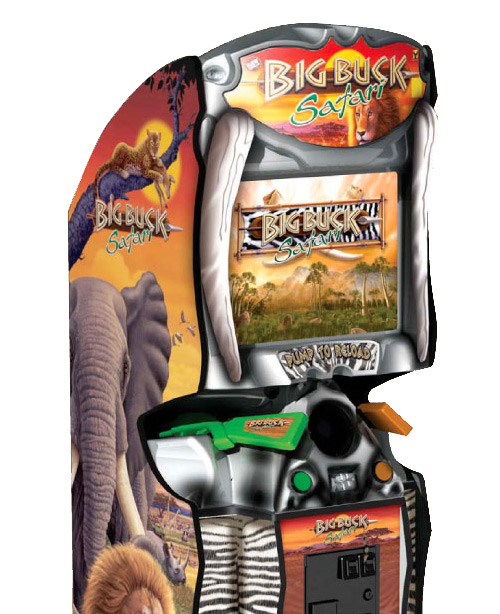
Big Buck Hunter Safari
$ 4,595.00

Big Buck Hunter Safari Arcade Game
This is a Big Buck Hunter safari arcade game made by Raw Thrills and released in 2007. Big Buck Safari offers eight ‘Trophy Animals: Lions, Rhinos, Elephants, Panthers, Leopards, Giraffes, Zebras and Hippos. In this version, players will also find several new critters to hunt including Meekest, Chameleons, Frogs, Hyenas, Warthogs and spiders just to name a few. New main quarry animals to hunt include Gemsbok, Kudu, Sable, Cape Buffalo and Wildebeest and there is also 15 new bonus rounds including Shrunken Head, Market and the “Tarantula” Bonus to name a few.
Description
Additional information.
This is a Big Buck Hunter Safari arcade game made by Raw Thrills and released in 2007. Big Buck Safari offers eight ‘Trophy Animals: Lions, Rhinos, Elephants, Panthers, Leopards, Giraffes, Zebras and Hippos. In this version, players will also find several new critters to hunt including Meekest, Chameleons, Frogs, Hyenas, Warthogs and spiders just to name a few. New main quarry animals to hunt include Gemsbok, Kudu, Sable, Cape Buffalo and Wildebeest and there is also 15 new bonus rounds including Shrunken Head, Market and the “Tarantula” Bonus to name a few.
Related products


After Burner

Asteroids Deluxe
Are you looking for….

Accepted Payment Methods
Featured products.

Product categories
- Bargain Corner
- Cocktail Tables and Other Games for Sale
- Pinball Games for Sale
- Stern Pinball Games For Sale
- Vintage Arcade Games for Sale
Site Search

Share ×

Scan the QR code and open PeakVisor on your phone
❤ Wishlist ×
See all region register, peakvisor app, khanty-mansiysk autonomous okrug – ugra.
Welcome to the land of sheer silent whiteness. Its vast expanses are filled with fresh Arctic air, howling winds, and the spirit of true adventure. Come with us to the lands of the ancient Khanty and Mansi tribes that survived in this harsh climate of the Nether-Polar Urals . See the mountains that defy any logical or geological reason for their existence. Experience the wonders of this sparsely populated land where you can hardly see a human trace. Welcome to Yugra!
Flora & Fauna
Water resources, landmarks and tourism, major mountains, mount narodnaya, mount zaschita, mount neroyka, the pyramid mountain, samarovskaya mountain, ski and sports facilities, protected sites, reserves, national and natural parks, rivers and lakes, major cities, khanty-mansiysk.
The Khanty-Mansiysk Autonomous Area – Yugra (KhMAO) is located in the central part of the West Siberian Plain, stretching from west to east from the Ural Range to the Ob-Yenisei Watershed. The vast areas of this plain, as well as the Lower Priob region, are considered one of the most recently inhabited areas.
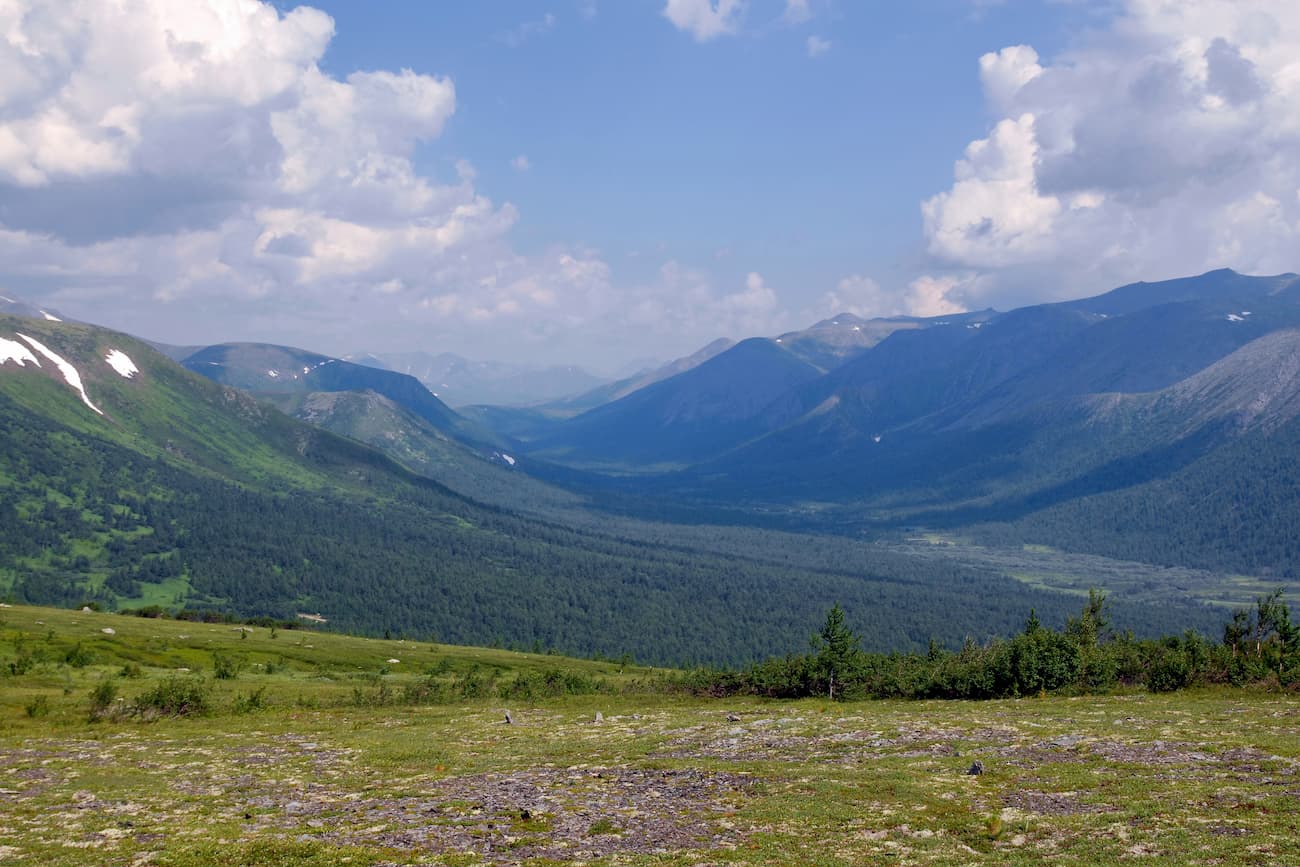
The Khanty-Mansiysk Autonomous Area (KhMAO) was established in 1930. Its name comes from two main northern indigenous peoples – the Khanty and the Mansi. From 1944 it was legally part of the Tyumen Region , but in 1993 the Area received autonomy and became a full-fledged territorial entity of the Russian Federation. It is a part of the Urals Federal District. The administrative centre is the city of Khanty-Mansiysk , whereas the largest city is Surgut. The word Yugra was introduced to the name of the Khanty-Mansiysk Autonomous Area in 2003 to pay tribute to the old name used by the locals to call the territories lying beyond the North Urals.
The KhMAO borders the Komi Republic in the north-west, the Yamalo-Nenets Autonomous District in the north, the Krasnoyarsk Area and the Tomsk Region in the east and south-east, the Tyumen Region in the south and the Sverdlovsk Region in the south-west.
The area of the territory is 534,801 sq.km, the length from north to south is 800 km, from west to east is 1400 km. The population of this huge territory is 1,674,676 people as of 2020, which is the same amount as people living in Barcelona or Munich.
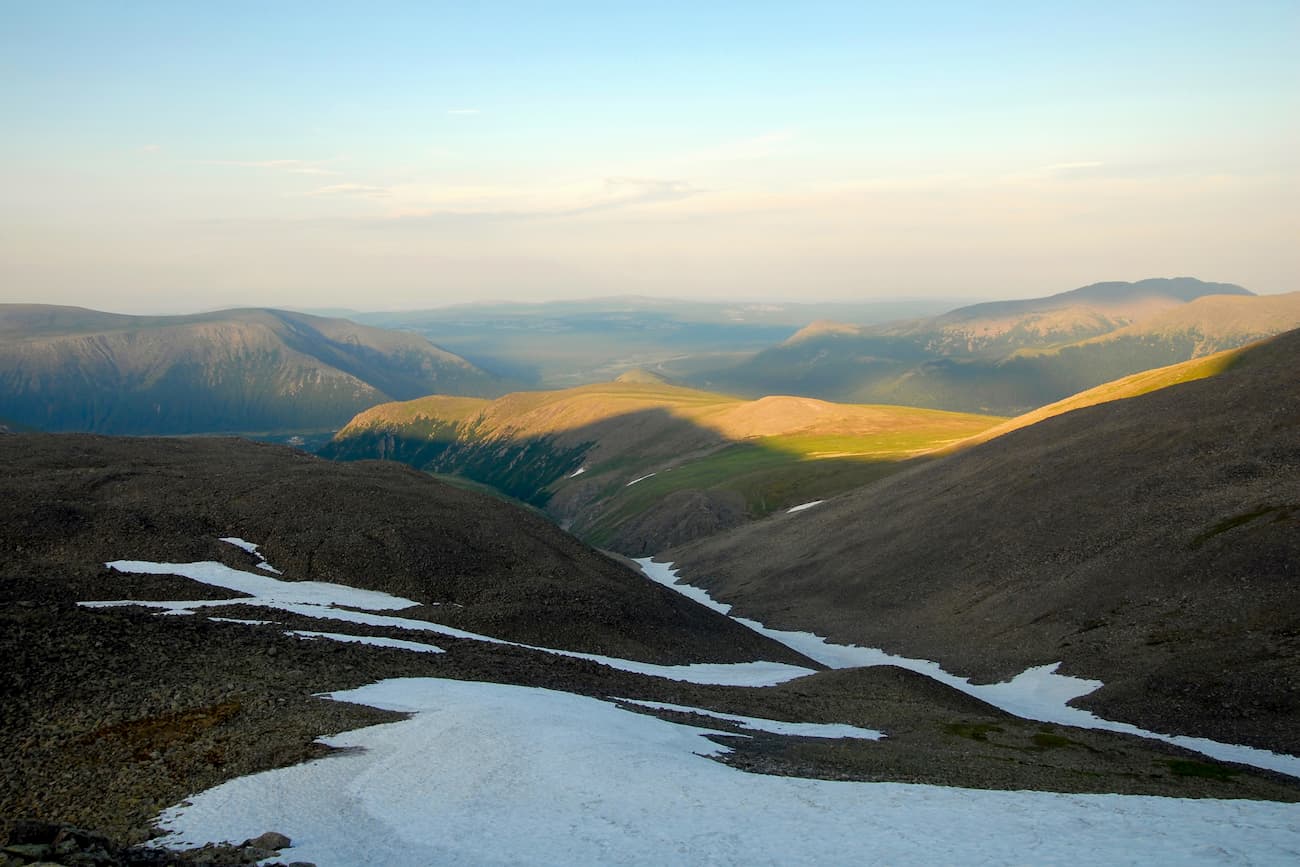
The main part of the territory is a huge, poorly dissected plain where absolute elevation marks rarely exceed 200 meters above sea level. The western part of the KhMAO territory is characterized by low and middle mountainous terrains with some Alpine relief featured in the Subpolar Urals. Here are ridges and spurs of the mountain system of the North Urals and the Subpolar Urals. The maximum absolute elevations are on the border with the Komi Republic . Mount Narodnaya (1,895m) is the highest peak.
More than 800 species of higher plants grow in the Khanty-Mansi Autonomous Area . Almost the entire territory is covered by taiga forests that occupy about 52% of the area. Spruce, fir, pine, cedar, larch, birch, alder grow here. In the northern parts of the area, the composition of the vegetation is greatly influenced by perennial permafrost. Light lichen grasslands which are used as deer pastures are widespread there. Tundra dominates in the mountainous and hilly areas. River floodplains and lowlands are characterized by meadow vegetation, the so-called water meadows. High floodplains of large rivers are mainly covered with woods that mainly feature willows, birches and aspens. Forests and swamps are rich in berries and various valuable plants, most of which are used in traditional indigenous medicine.
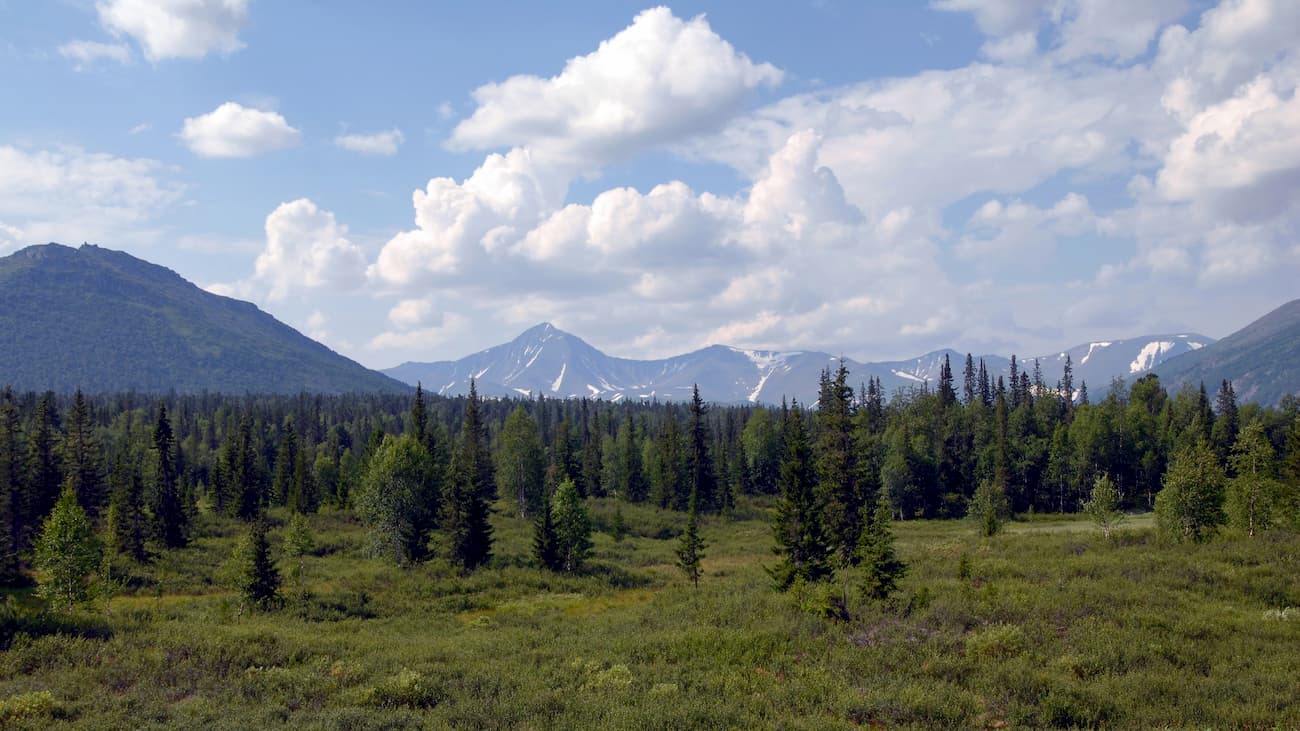
The animal world is typical for the Russian taiga zone. There are 369 species of vertebrates. Mammals are represented by 60 species (28 of them are commercial species). The most common and valuable of them are wild reindeer, elk, fox, sable, fox, squirrel, marten, ermine, Siberian weasel, polecat, mink, weasel, otter, hare and others. Wolverine and West Siberian river beaver are included in the Red Book of Russia.
There are 256 bird species in the region, including 206 sedentary and nesting species. Some rare bird species are listed in the Red Book. There are 42 species of fish in rivers and lakes. Of these, 19 species are commercial, among them are starlet sturgeon, lelema, muksun (whitefish), pelyad, chir, lake herring, wader, tugun, freshwater cod, pike, ide, roach, bream, fir, perch, ruff, golden and silver crucian carp, carp (carp is grown in the cooling ponds of the Surgutskaya and Nizhnevartovskaya hydroelectric plants). Sturgeon is listed in the Red Book. There is an abundance of mosquitoes and gnats in the area, the greatest activity of which is in the second half of summer.
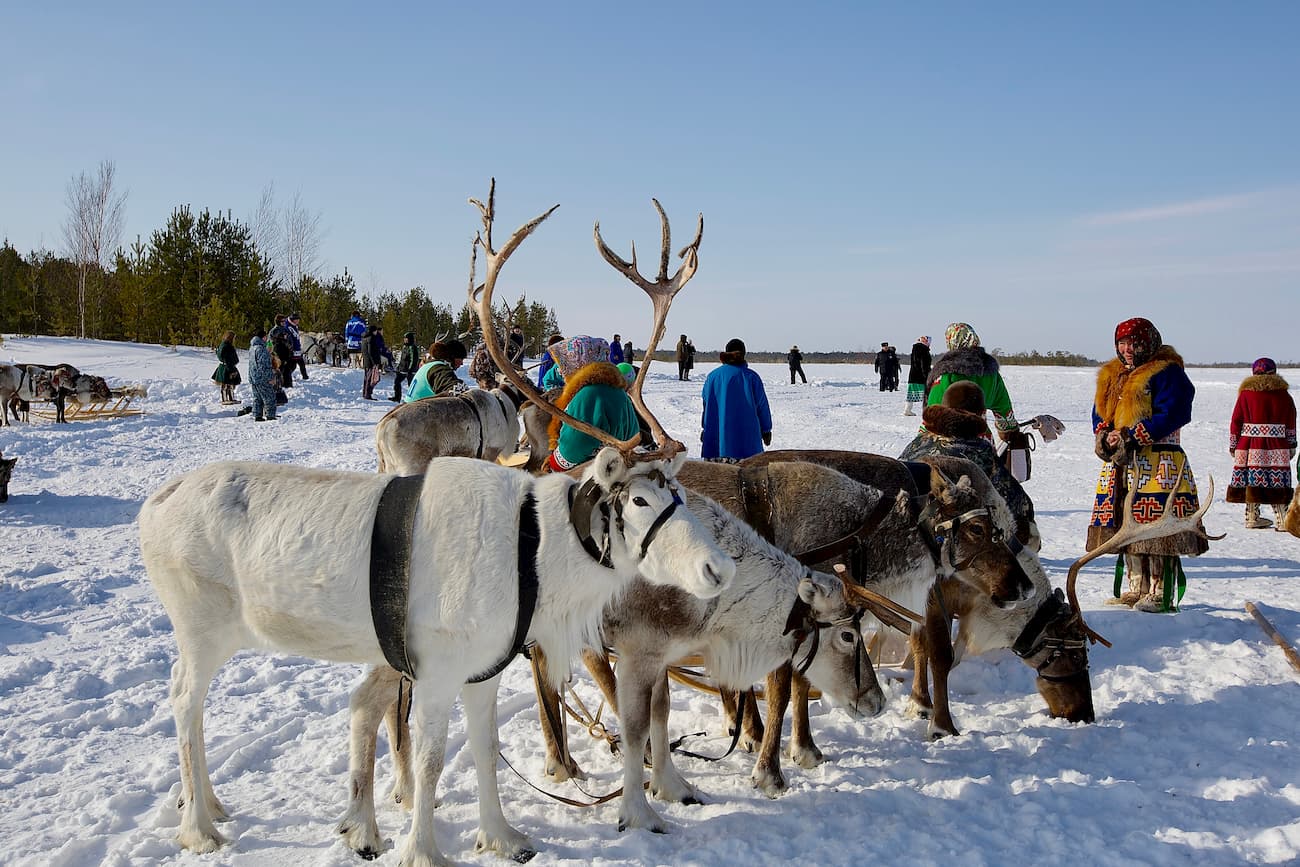
Yugra can boast of over 2 thousand large and small rivers, the total length of which is 172,000 km. The main rivers are the Ob (3,650 km), the Irtysh (3,580 km). These are some of the largest rivers in Russia. Other significant rivers include the tributaries of the Ob (the Vakh, Agan, Tromyogan, Bolshoy Yugan, Lyamin, Pim, Bolshoy Salym, Nazym, Severnaya Sosva, Kazym rivers), the tributary of the Irtysh (the Konda River) and the Sogom River. Ten rivers are over 500 km long. All the Yugra rivers with the exception of the rivers in the Ural part of the region are characterized by rather slow currents, gentle slopes, some surge wave phenomena, spring and summer floods. The Ob River basin extends over a distance of 700-200 km from the mouths of its tributaries. Such abundance of water facilitates the appearance of floodplain swamps and seasonal lakes.
The region's swamps are predominantly of the upper and transitional type. Those water basins occupy about a third of the region. About 290,000 lakes with the area of more than 1 ha are surrounded by swamps and forests. The largest lakes are Tursuntsky Tuman, Levushinsky Tuman, Vandemtor and Trmemtor. The deepest lakes are Kintus (48 m) and Syrky Sor (42 m). However, most of the lakes (about 90%) are modest and quite small and have no surface runoff.
The area is rich in resources of fresh, mineral and thermal underground waters, which are still insignificantly used.
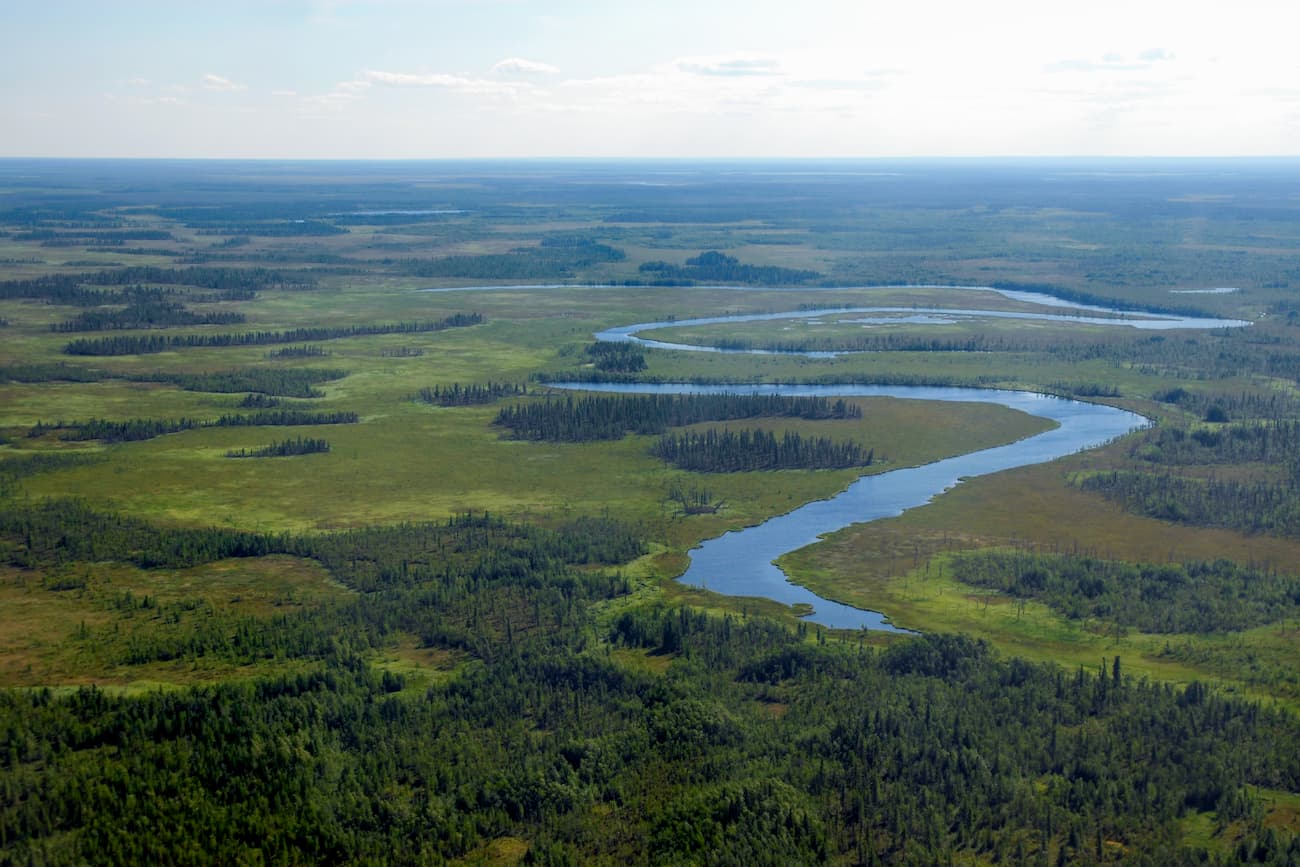
The climate is moderately continental. Winters are harsh, snowy and long, and summers are short and relatively warm. The territory is protected from the west by the Ural Mountains but its openness from the north has a significant impact on the climate formation because cold air masses from the Arctic freely penetrate the area. The flat character of the terrain with a large number of rivers, lakes and swamps also has its impact. Most of the precipitation falls during the warm seasons. But even with a small amount of precipitation, their evaporation is very low, which as a result contributes to the formation of the zone of excessive moisture throughout the Yugra. The snow cover is stable from late October to early May, its height varies from 50 to 80 cm. The region is characterized by a rapid change of weather conditions, especially in transitional seasons (autumn and spring), as well as during the day. Late spring and early autumn frosts are rather frequent and can happen even until mid-June. Average January temperatures range from -18ºC to -24ºC (0 F to -11 F) and can reach -60ºC to -62ºC (-76 F to -80 F) when the northern cold air masses break through. The average temperature in July, the warmest month of the year, ranges from +15ºC to +20ºC (+59 F to +68 F) and on very rare days can reach a maximum temperature of +36ºC (+97 F). The prevailing wind direction is north in summer and south in winter.
The weather in the mountains is quite changeable and cool even in summer. The best time to visit the region's mountains is between July and mid-August.
The Yugra of the Khanty-Mansi Autonomous Area has a huge natural resource potential. These are oil and gas deposits, forests, gold and iron ore deposits, as well as bauxites, copper, zinc, lead, niobium, tantalum, brown and hard coal deposits, rock crystal, quartz and piezo quartz, peat deposits, etc. The region has plenty of natural resources. In terms of natural gas reserves, the Yugra ranks second in the Russian Federation after the Yamalo-Nenets Autonomous District .
The industry is dominated by oil and gas production, power generation and processing industries, including woodworking except for pulp and paper production.
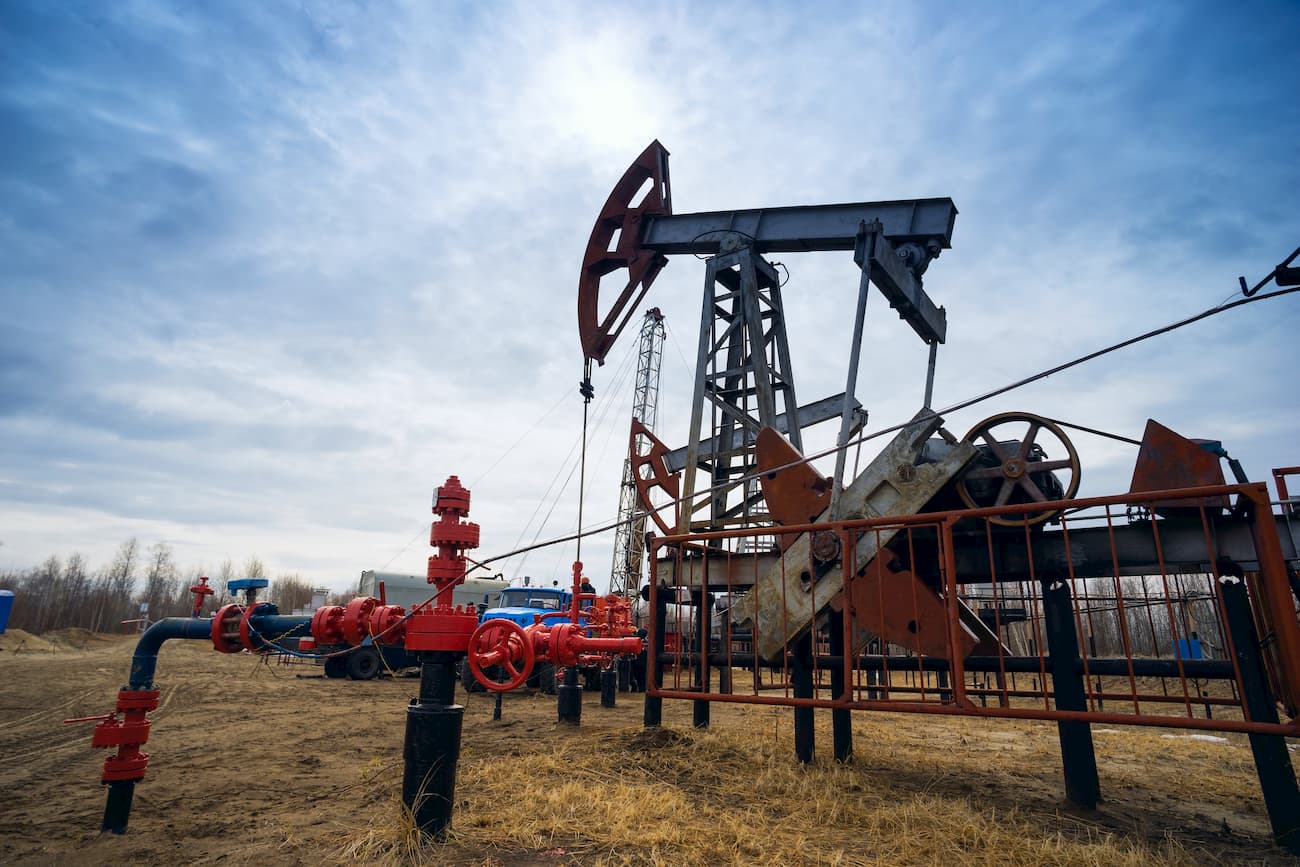
The Khanty-Mansi area has very developed tourism of all kinds. There is a modern infrastructure for cultural exploration as well as for active recreation.
Fans of sports and eco-friendly tourism will be able to conquer majestic mountains and raft down picturesque rivers, enjoy the beauty of nature in nature reserves and natural parks. The hills and mountains of this area open up endless opportunities for skiing and snowboarding.
The mountainous part of the Subpolar Urals located on the territory of the Khanty-Mansi Autonomous Area is very beautiful. The highest peaks of the Ural Mountains are situated here.
Being the highest point of the whole Urals, Mount Narodnaya (1,895 m), also known as Naroda and Poenurr and translated as People's Mountain is territorially situated in the Subpolar Urals, on the border of the Yugra Area and the Komi Republic . It is the highest point in European Russia outside the Caucasus. This leads to its large topographic prominence of 1,772 metres (5,814 ft).
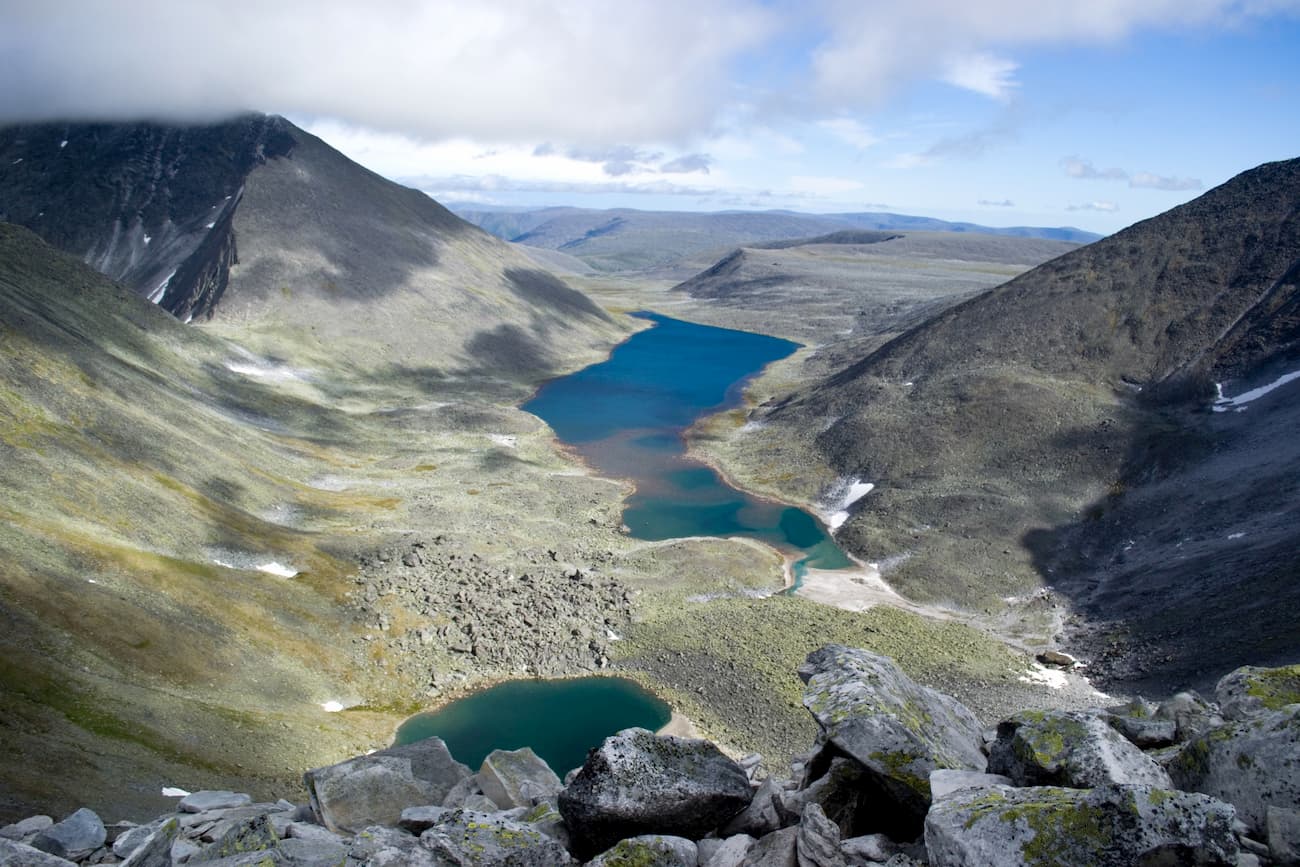
The top of the mountain is half a kilometre from the border towards Yugra. As for the name of the mountain, scientists could not come to a common opinion for a long time, so there are two versions. According to one version, in the Soviet years, an expedition of pioneers gave the mountain a name in honour of the Soviet people - Narodnaya (the stress is on the second syllable). According to the other version, even before the arrival of the first Soviet tourists, the peak was named after the River Naroda (the stress is on the first syllable) flowing at the foot of the mountain. The Nenets peoples called the River Naroda Naro, which means a thicket or a dense forest, and the Mansi peoples called it Poengurr or Poen-urr, which translates as the top, or head. The maps used to refer to it as Mount Naroda or Mount Naroda-Iz. Nowadays, it appears everywhere as Narodnaya.
In the 1980s, someone set a bust of Lenin on the top of the mountain. Its remains can be found there to this day. There is one more symbolic relic there – some Orthodox believers erected a worship cross on top of Mount Narodnaya after a Procession of the Cross.
The slopes of the mountain are steeper in the north-east and south-west and there are many steep rocks on them. The south-eastern and northern parts of the mountain are more gentle but they are also covered with scree. Be vigilant and careful when climbing! On the slopes of the mountain, there are many not only boulders but also caverns filled with clear water as well as ice. There are glaciers and snowfields. From the north-eastern part of the mountain, you can observe Lake Blue near which tourists and travellers like to make bivouacs.
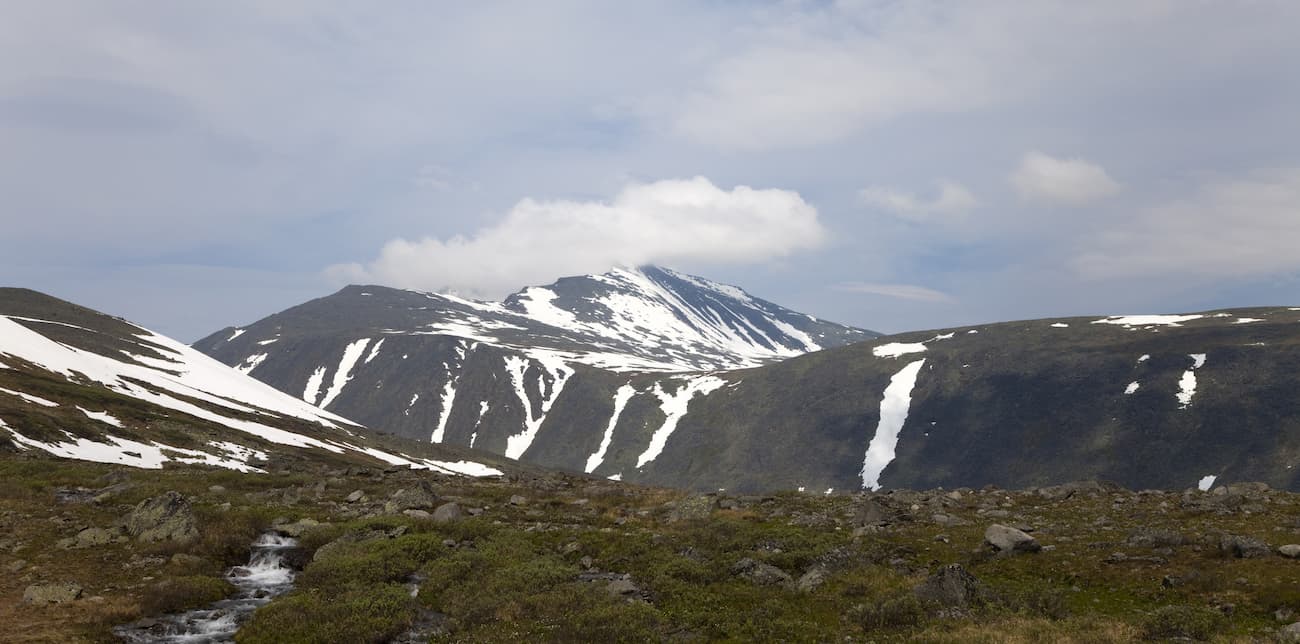
Mesmerizing with its beauty and inaccessibility, it attracts many tourists and fans of active recreation. This majestic mountain is quite remote from the settlements, so getting to it is not an easy task. The mountain is located in the Yugyd Va National Park , so it is necessary to register in advance and get a visit permit from the park administration. How to get to the park administration and get a permit, read the article on the Yugyd Va National Park .
Mountain Zaschita (1,808 m) is the second-highest peak in the Ural Mountains, after Mount Narodnaya . Mysteriously, the name of the mountain, which roughly translates as Defense or Protection Mount, does not correlate in any way with the Mansi names of the nearby mountains and rivers. The origin of the name is unknown. There are some speculations but we will consider just one of them. On the map of the Northern Urals which was made by the Hungarian researcher Reguli the closest peak to Mount Narodnaya was called gnetying olu. Its location coincides with that of the present-day Mount Zaschita . The name gnetying olu in the Mansi can be deciphered as a mountain on which there is some help from ice. The mountain is believed to protect deer grazing on glaciers from mosquitoes. So, early topographers called the mountain more briefly – Mount Defense. Indeed, the slopes of this mountain are covered with a lot of snow and glaciers (the Yugra, Naroda, Kosyu, Hobyu glaciers and others). And it is here that the Mansi shepherds bring their deer which can rest on glaciers and snow. Summarizing all the above, we can say that Zaschita Mount is to some extent protection for deer from mosquitoes. The very name Zaschita appeared on maps with the beginning of hiking tours in the Subpolar Urals.
Mount Neroyka (1,645 m) is 100 km from Neroyka village, the closest tourist base to this peak. In the 1950s, people who were engaged in quartz mining near the mountain worked and lived in this base. Later, a gravel road was built from the village of Saranpaul to the mountain for large-scale development of the quartz deposit. In recent years, the road has not been much used and is practically not cleaned from snow in winter. There has been a plant built 20 km down from the mountain for primary processing of quartz with the use of nanotechnologies. There is an annual big camping event near the mountain. It is organized by the Tourism Department of the Khanty-Mansi Autonomous Area. You can have a 1-hour helicopter ride to the mountain from the village of Saranpaul. Should you wish to fly from the city of Khanty-Mansiysk , be prepared to fly over the taiga for 2.5-3 hours.
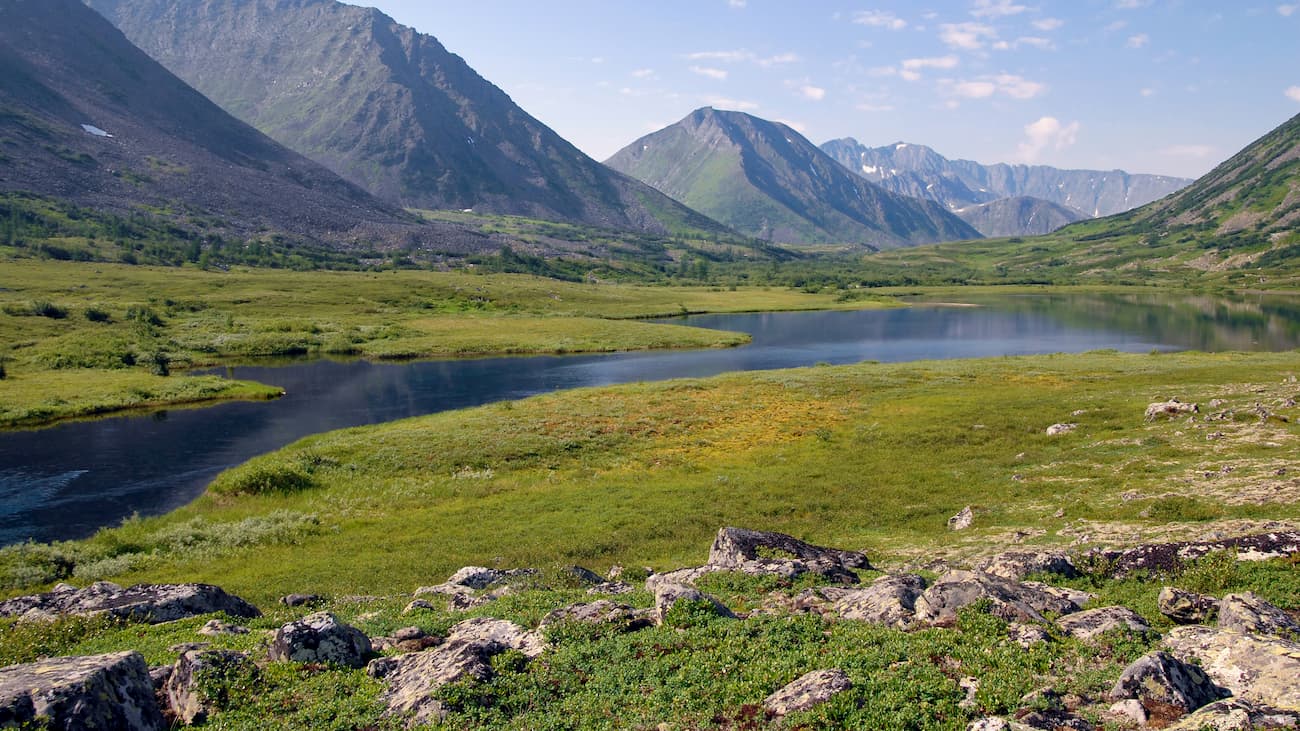
Quite inquisitive tourists happened to discover, by a lucky chance, a Pyramid similar to that of Cheops but four times bigger. It is located on the territory of the Narodo-Ityinsky Ridge. The closest to the pyramid is the village of Saranpaul. The sizes of the found pyramid are as follows: the height is 774 m, in comparison to the Egyptian pyramid which is 147 m; the length of a lateral edge is 230 m whereas the Egyptian pyramid is 1 km. The pyramid is located precisely according to the cardinal directions, there is not a single degree deviation at that. The origin of the pyramid is unknown, scientists are still making assumptions. No traces of human activity were found near the pyramid. The only way to get here at this time is by helicopter.
Samarovskaya Mountain is another wonder that is baffling many people. It is dividing the city of Khanty-Mansiysk into northern and southern parts. Few now living residents know that in the old days the highest part of the modern city used to bear a plural name of the Samarovsky Mountains among which there were Mount Palenina, Komissarskaya, Miroslavskaya, Filinova, and Romanova. Originally, there was a village called Samarovo amidst these mountains. Until now, many issues bewilder both residents and scientists. How could a mountain form in the middle of the West Siberian Plain? What is inside it? Won't the weight of the buildings erected on the top of the mountain affect its height? The uniqueness of Samarovskaya Mountain is that it consists of numerous large stones, boulders, rocks that are absolutely foreign to this area. Scientists have not yet come to a consensus on the mountain’s origin.
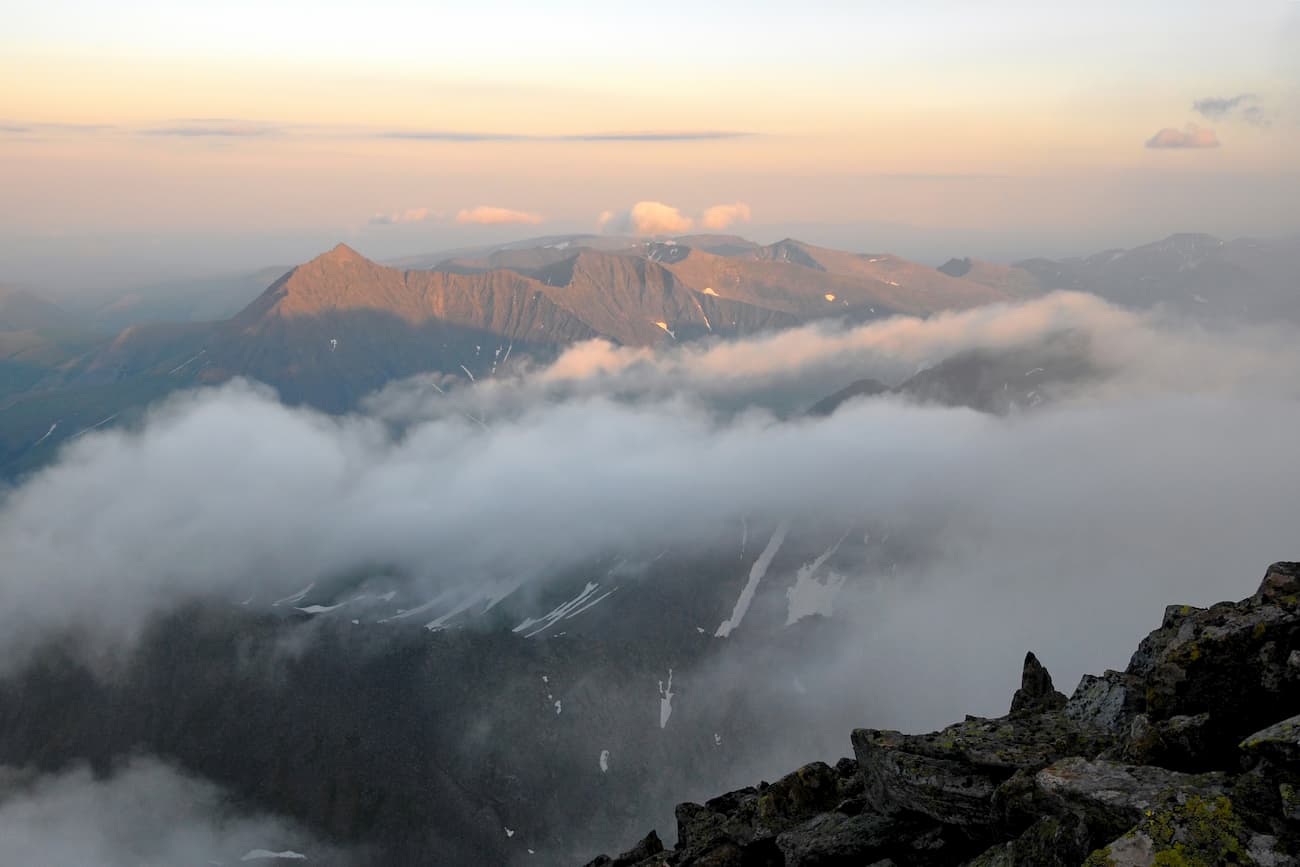
The Yugra is very famous for its ski resorts, the main of which are:
- The Cedar Ravine ski resort (Surgut city, Naberezhny Ave. 39/1)
- Three Mountains (Trekhgorie) ski resort (30 km from Nizhnevartovsk, Ermakovsky settlement)
- Stone Cape (Kamenniy Mys) ski resort (near the city of Surgut)
- Pine Urman ski resort ( Khanty-Mansiysk , Sportivnaya Str., 24)
The far-away lands of the Yugra are the blessed sanctuaries for many animals as the area is rather hostile to a human There are reserves, natural parks, wildlife sanctuaries here that aim to protect the national treasures of the lands. Having visited these regions once, you would crave for coming back again and again to feel that unique sense of unity with nature, to forget about the urban fuss and and hustles whatsoever. The harsh but beautiful nature of this extraordinary area leaves an indelible trace in the soul of every person.
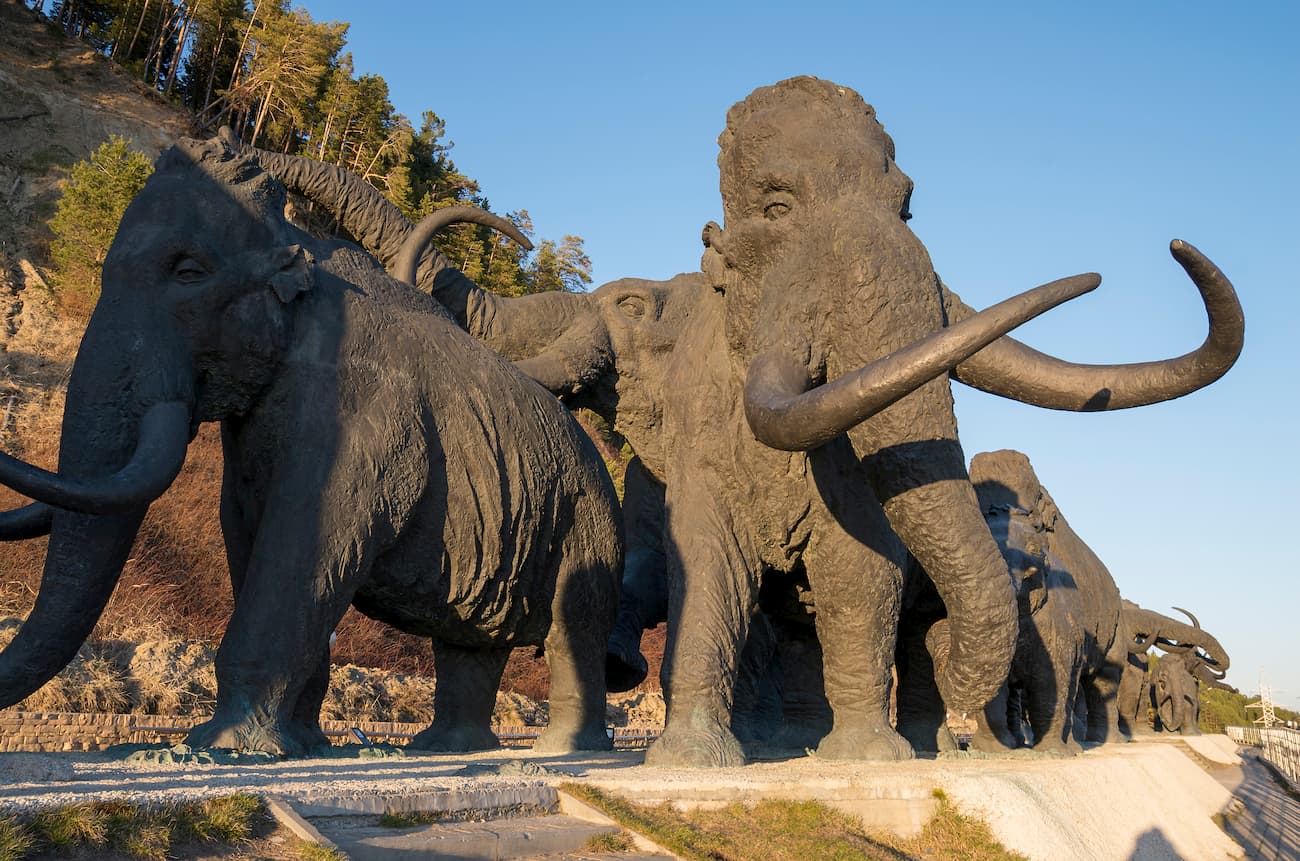
On the territory of the district there are 25 specially protected natural areas, the most famous of them are:
- The reserves are two: the Malaya Sosva Reserve and the Yugan Reserve, the latter was established in 1982 as the largest reserve of taiga landscapes. The purpose of the reserves was to study unobtrusively and carefully preserve the endemic flora and fauna without disturbing natural processes. Hunting and economic activities are prohibited here, which is important for the preservation of natural ecosystems.
- The natural parks are the Samarovsky Chugas Nature Park, the Siberian Sloping Hills (Uvaly), the Numto (also called Lake Numto), and the Kondinskie Lakes.
These reserves and natural parks offer tourists their own excursion programs to make visiting their territory much more enjoyable and educational.
The Samarovsky Chugas Nature Park is located in the center of Khanty-Mansiysk , on a small hill between the Ob and Irtysh rivers.
The territory of the Siberian Sloping Hills (Uvaly) natural park is 350 km away from the city of Khanty-Mansiysk . You can get there by helicopter or by plane. The office of the park is located at 7a Pionerskaya Street, Nizhnevartovsk.
The Kondinskie Lakes Natural Park is located 380 km from Khanty-Mansiysk . Half of the park is covered with swamps, but there is also a recreational area. There you can rest, swim, do some amateur fishing, picking berries (cowberries, cranberries) and mushrooms is permitted. There is only one independent walking route here, it runs for 3 km in the deep forest. It is a cool place for kids since the park is equipped with sports grounds, a pool and a small zoo where the kids can interact with brown bear cubs. What else, try the TaiPark, it is a rope course running at the height of 2.5 meters, having 15 stages, the full length is 125 meters. There is an opportunity to order water walking tours in the town of Sovetsky, which can be reached by train from Khanty-Mansiysk .
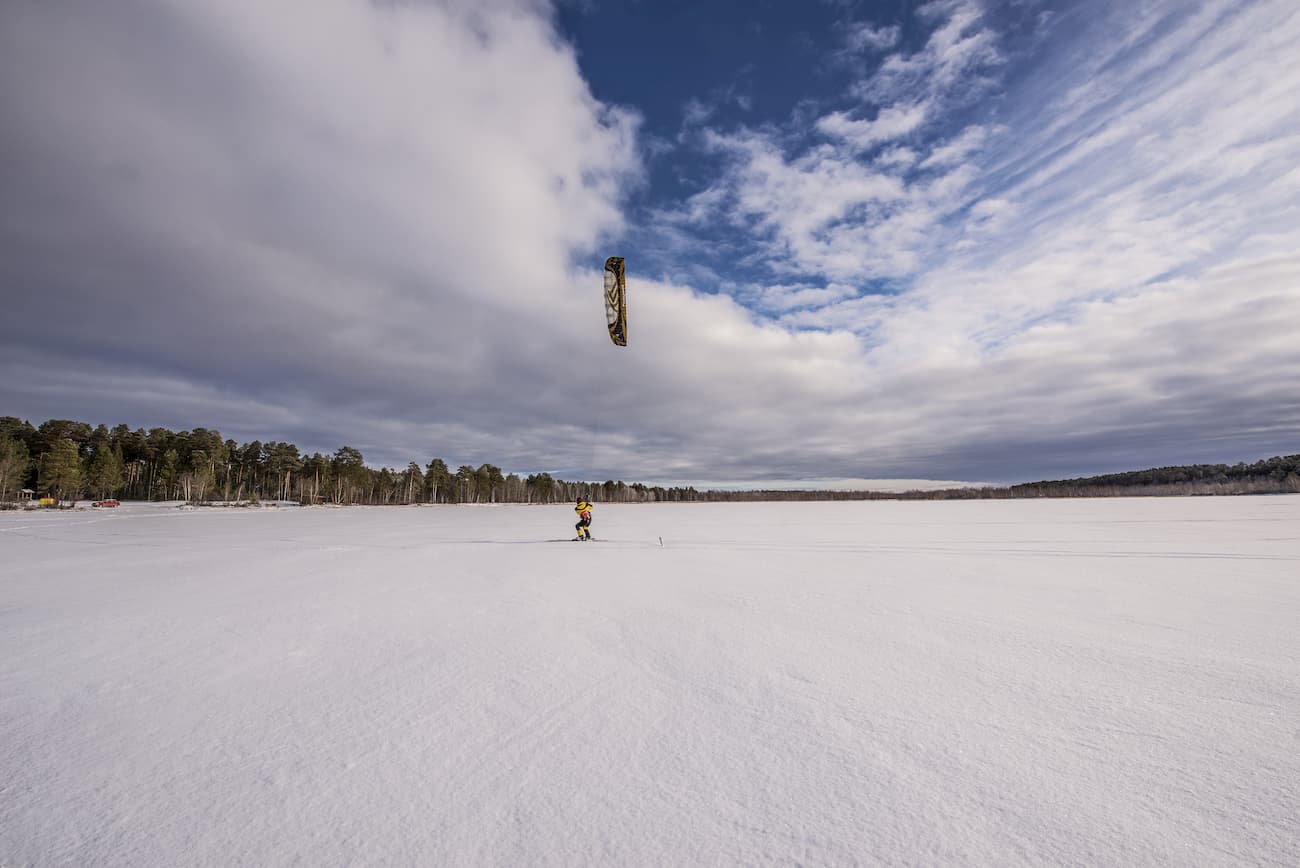
The Numto Nature Park is located almost in the center of the West Siberian Plain, in the Beloyarsk district of the Khanty-Mansi Autonomous Area, 300 km from the city of Surgut and 200 km from the town of Beloyarsk. It is located on the border of Yugra and Yamalo-Nenets Autonomous Area. The administration of the park is located at 2, Beloyarsky micro-district, 4a. The territory of the natural park is a treasure trove of archaeological and ethnocultural monuments. As of today, there have been discovered 20 architectural monuments, including fortified and not fortified settlements, places of worship abandoned by the peoples who lived here from the Stone Age to almost the present day. Researchers have also found 65 monuments of ethnic value, the main of which are worship objects, sacred places and cemeteries.
The Malaya Sosva Reserve includes several subordinated territories and sanctuaries, including Lake Ranghe-Tour. The reserve offers a 4-km walking guided route that gets the visitors introduced to the typical features and characteristics of flora and fauna of the region. The route is called Bear Trail and you can spot bears there (don’t come close though, we’ve already written how to behave if you meet a bear in the wild). Also, you will see the River Malaya Sosva, some marshes, ancient cultural monuments and other nice sights. Permission to visit the reserve can be obtained from the administration of the reserve at Lenina Str. 46, town Sovetskiy.
As to the Yugan Nature Reserve , it is inaccessible to common hikers who are afraid of flying since there are no roads to it. The only way to get there is taking a helicopter ride. You also must obtain a permit in the administration of the reserve, go accompanied by employees of the reserve, and only on special transport of the reserve (motorboat, snowmobile). The central manor of the Reserve and the administration are located in the village of Ugut. To get to this village, you should first go to the town of Surgut, then go to the town of Pyt-Yakh, and from it there is a road to the village of Ugut. It is about 100 km from Ugut to the southern border of the reserve i, and another 25 km to the nearest cordon. The administration works from Monday to Friday. You can request a permit via mail at [email protected] , order a guided tour at [email protected]
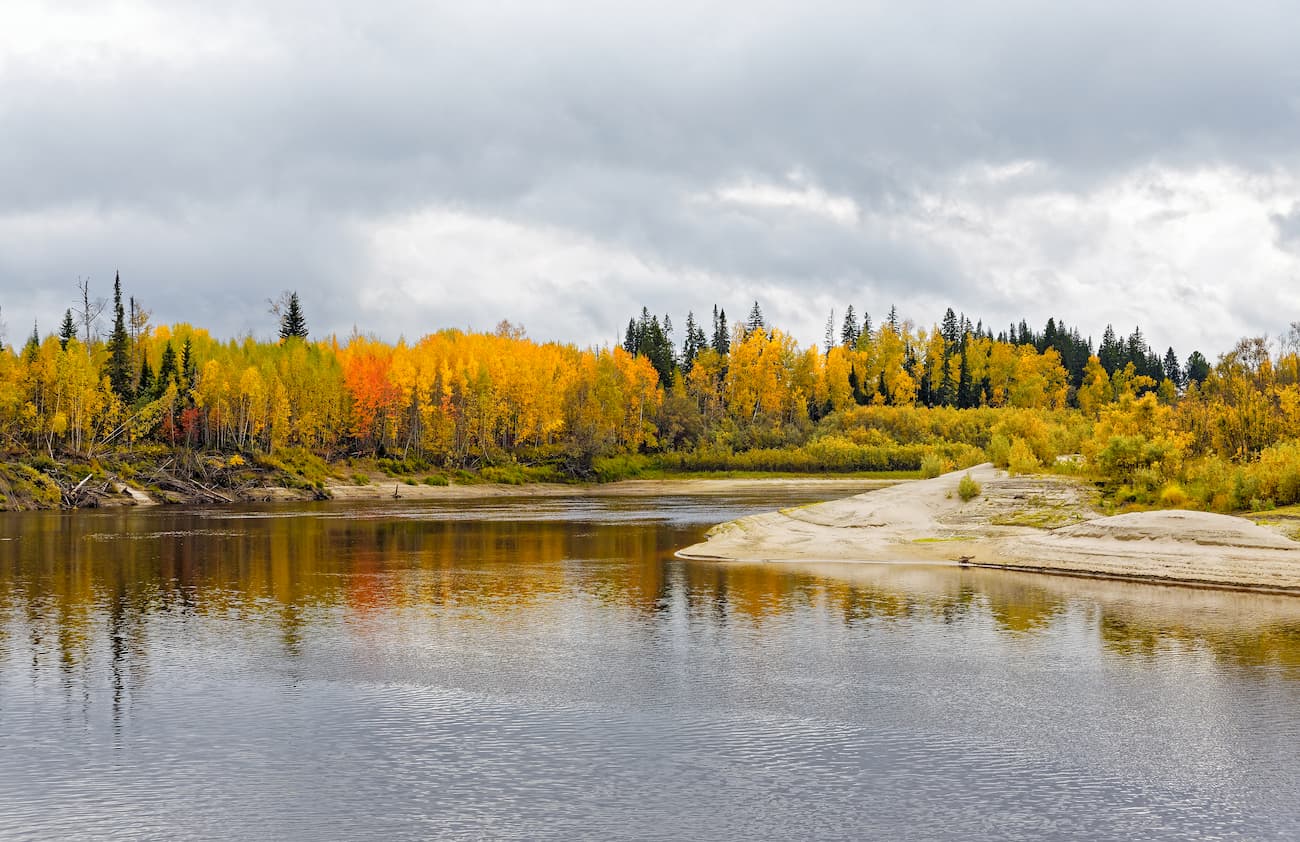
The Yugra lands are heaven for water sports aficionados. They can have some awesome fishing or go rafting along such rivers as: the river Naroda, the Deep Sabun, etc.
The Naroda River is 140 km long. It is the left tributary of the Manya River located in the Ob River basin. The river has its origin on the south-western slope of Mount Narodnaya . It is a mountain-taiga river with rapids, swifts, numerous rolls, which attracts interest among water tourists. However, it is usually not rafted very often.
The Deep Sabun River flows through the territory of the Siberian Sloping Hills Nature Park. The park has developed multi-day water routes. It is possible to raft along the river in summer and to go skiing along it in winter.
The Kondinskie Lakes are a system of lakes along the left bank of the Konda River. The largest lake is the Arantur, with pine forests on the northern side and sandy beaches well equipped for a nice relaxing me-time. The water heats up well in summer. The small river Okunevaya and the river Maly Akh flow into the lake. The Maly Akh comes in on the west side and connects lake Arantur with Lake Pon-Tour. This lake is the richest in fish, and there is also a parking lot for fishermen here. The streams connect Pon-Tour with small lakes Krugloe and Lopukhovoye. When you look at Lopukhovoe lake, you feel as if you have found yourself in a fabulous place: more than half of its surface is covered with white lilies, as well as yellow flowers of the water-beans. Then the river Big Akh, which flows into the river Konda, connects all the lakes into a single system. Along the river there are many archeological monuments such as forts and settlements which have paths to them. The southernmost lake of the park is Ranghe-Tour.
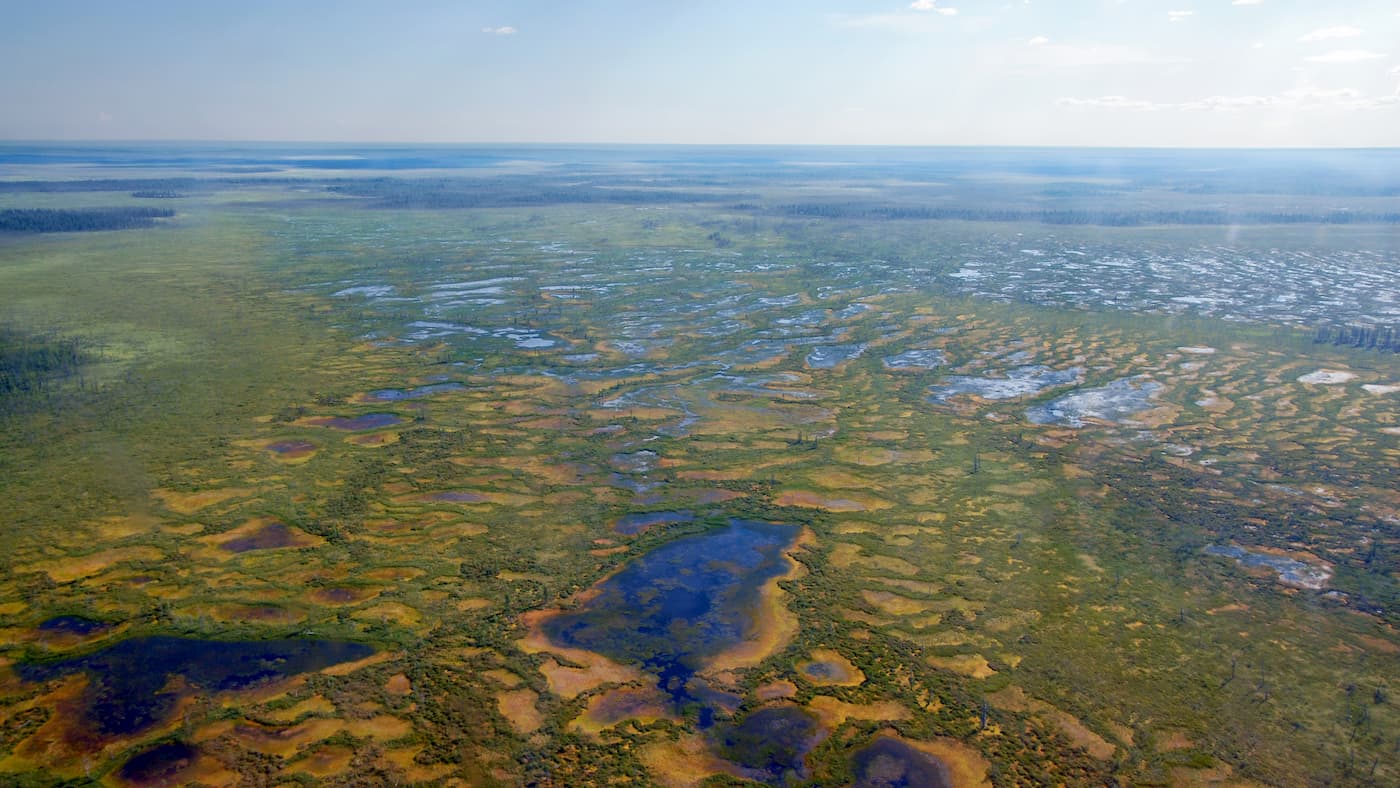
Yugra is not the easiest destination and not the most accessible, but the effort is well worth it. You should first get to the capital of Khanty-Mansiysk Autonomous Area – the city of Khanty-Mansiysk either by air or by train.
Khanty-Mansiysk is based on the premises of the former village Samarovo founded in 1582. It used to be the territory of the Khanty people and a pit stop for coachmen who rode their wagons across the country. The village was founded by Russian Count Samara, thus the name Samarovo. The modern city actually began to develop in 1930 because amidst the Siberian taiga there finally started to appear stone houses on the high bank of the Irtysh River. In 1940, the village was renamed into Khanty-Mansiysk by the name of the peoples living on this territory – the Khanty and the Mansi, and in 1950 it received the status of a town.
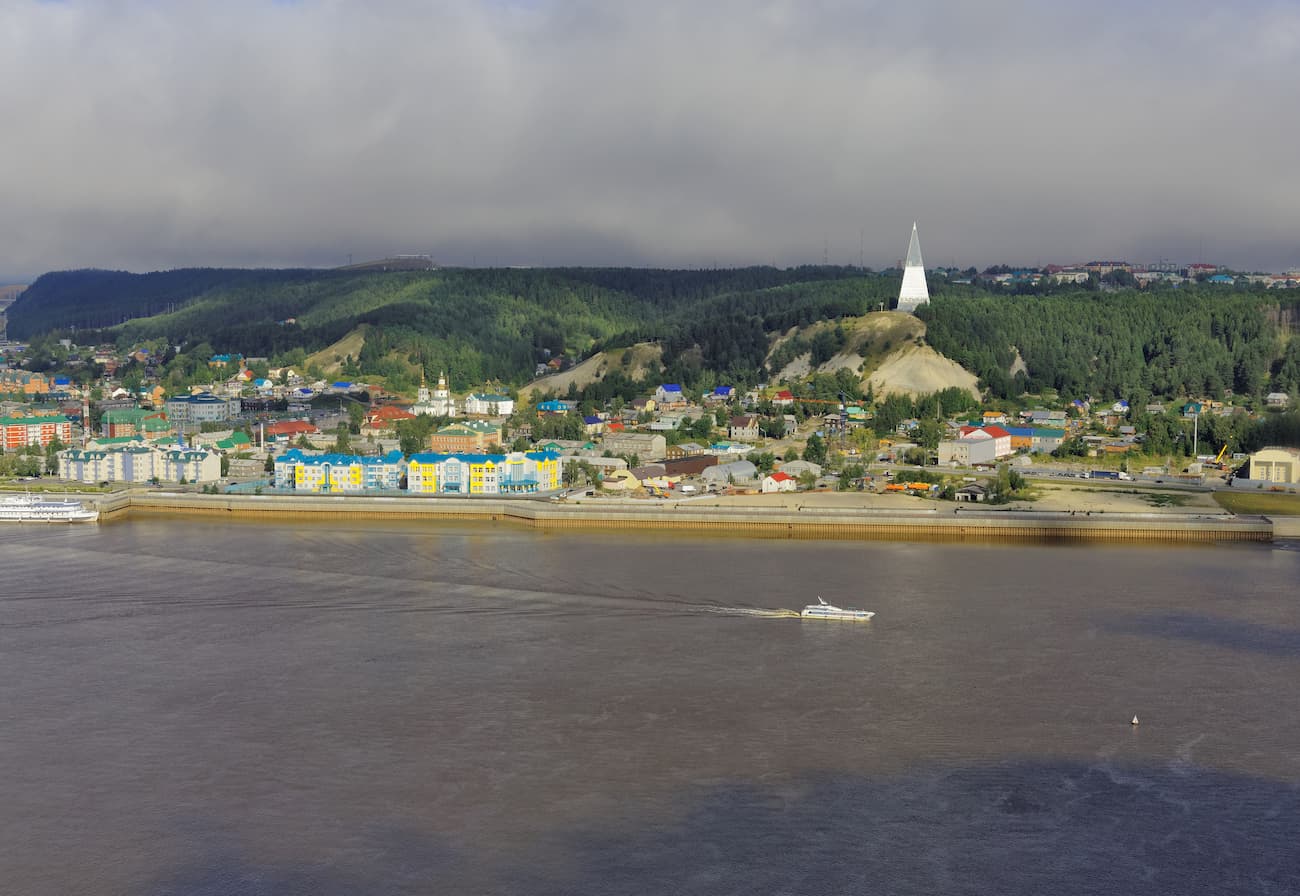
The city has several attractions. Mount Samarovskaya is probably the biggest natural and scientific wonder. It divides the city in two parts and causes many concerns for urban developers who always wonder whether this mountain can move making the buildings slide or even sink in.
Another beauty is the century-old cedar grove that is within the city limits. The grove is a part of the natural park Samarovsky Chugas. The word chugas in the language of the Khanty means a lonely hill in the low river floodplain.

The park is one of the main attractions of the city, it hosts an open-air ethnographic museum called the Torum Maa, a cultural and tourist complex called Archaeopark, a biathlon center. Kids and adults, nature lovers and fans of culture love this place dearly.
A memorial sign to Yugra's discoverers is installed on top of the Samarovsky Chugas. It is a tall stele pyramid divided into three portions. On the lower level, there is a restaurant, on the second level is a small museum, and on the third level there is an observation deck, 40 m above the ground, with a magnificent view of the Irtysh River and the river port. The pyramid is decorated by the bas-relief depicting the discoverers of the region, from the 16th-century Count Samara to the geologists of the 20th century.
Another trademark of Khanty-Mansiysk is the State Museum of Nature and Man. The museum hosts a gallery and a workshop of a famous artist G. Rayshev.
The city has a lot of small monuments generously spread around the city. There is the Khanty family resting on a camp, this monument is near the airport building. You can take a pic at the Golden Tambourine located at the intersection of Gagarin Street and Mira Street. Connoisseurs of culture should also visit the Sun – the Theatre of Ob-Ugrian Peoples, it is the world's first professional theatre of Khanty and Mansi peoples. And if you are travelling with kids, the Khanty-Mansiysk Puppet Theatre is a must-visit. In the period from May to October, you can take a boat ride to the confluence of two rivers – the Ob and the Irtysh. Yugra Service Co. operates such cruises, you can find more information locally at their address Tobolsk Trakt street 4, Khanty-Mansiysk .
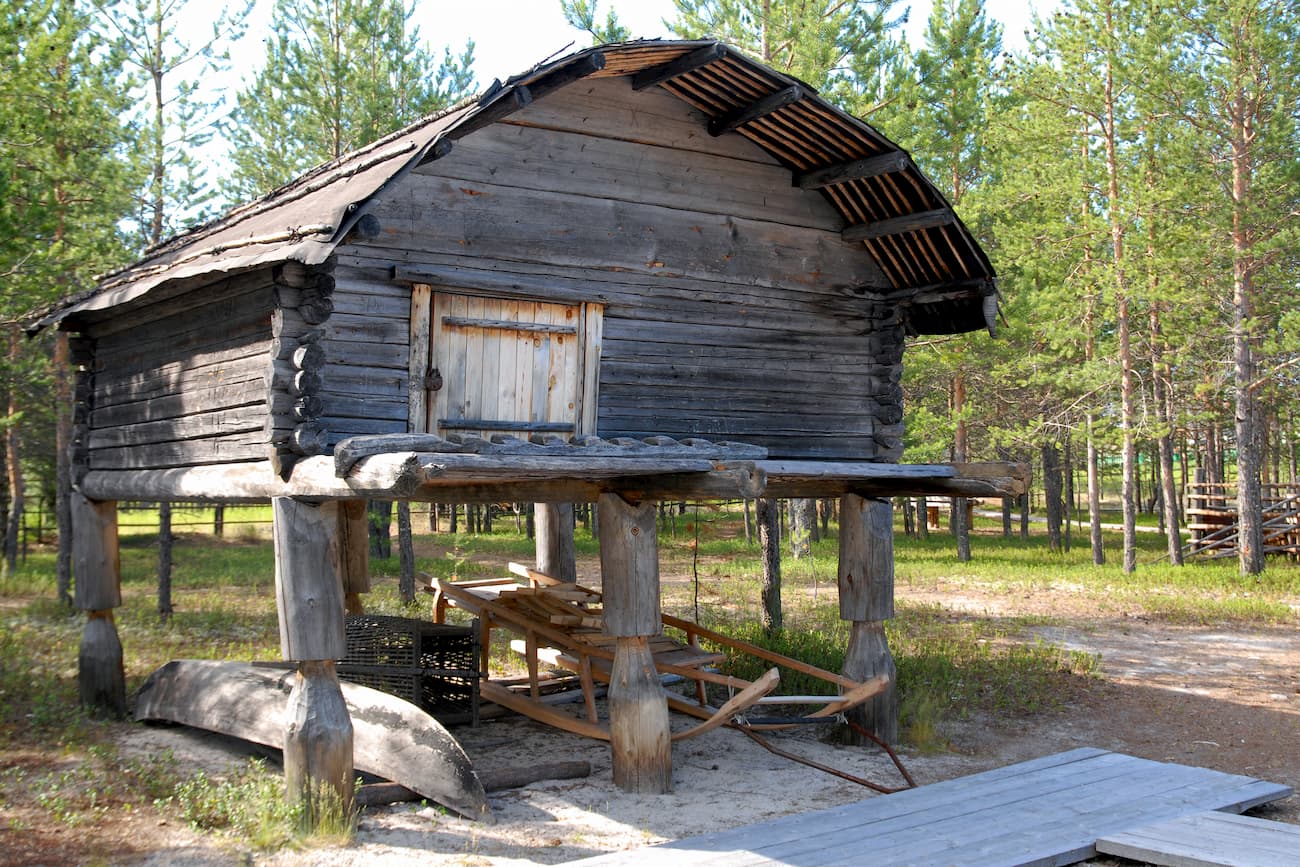
Explore Khanty-Mansiysk Autonomous Okrug – Ugra with the PeakVisor 3D Map and identify its summits .

PeakVisor Hiking Maps
Be a superhero of outdoor navigation with state-of-the-art 3D maps and mountain identification in the palm of your hand!
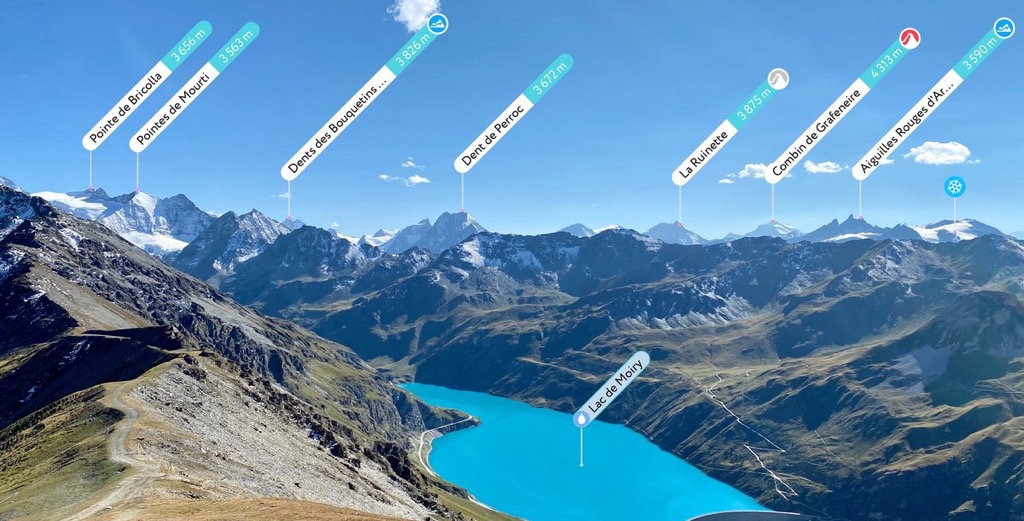
- Bahasa Indonesia
- Slovenščina
- Science & Tech
- Russian Kitchen
Khanty-Mansiysk: Why you simply must visit this northern land of mammoths
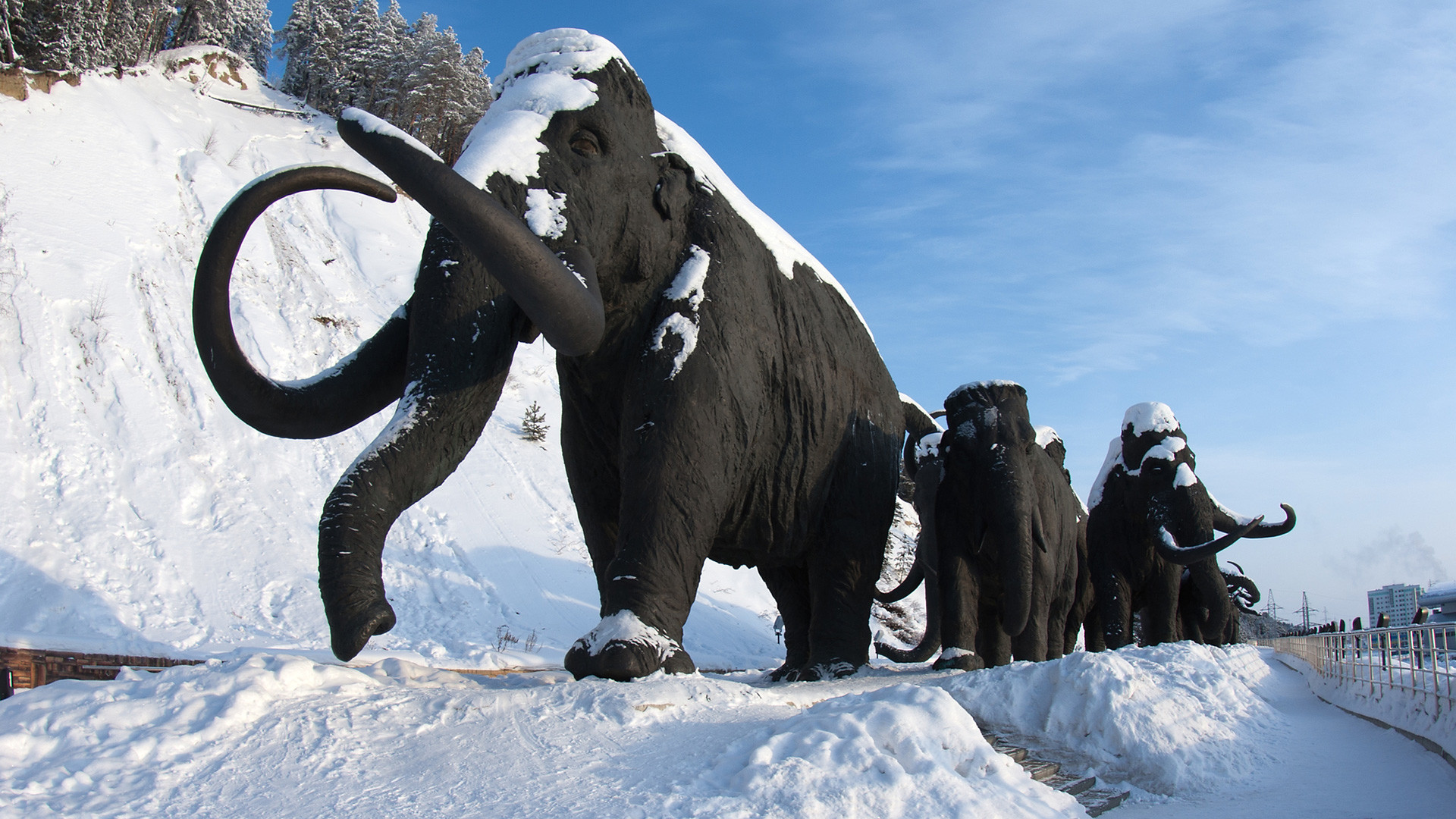
“I have been to Yugra many times. I was sworn in as a Siberian in a cedar forest,” producer Andrey Suleikov writes in the preface to a collection of legends called Yugra. It’s My Land . “I tasted lingonberries in the cold and could not tell whether the berries were coated in sugar or ice. I also enjoyed outdoor hot springs while taking a traditional Siberian bath."

Fuel pumping stations
Sounds more like time travel than a present-day tourist trip, doesn’t it? But that is what Yugra is like: a fusion between prehistoric things like mammoths and modernity, which has brought oil, gas and new buildings. Even the region’s official name (which is quite long: the Khanty-Mansi Autonomous Area – Yugra) combines the present with the past.
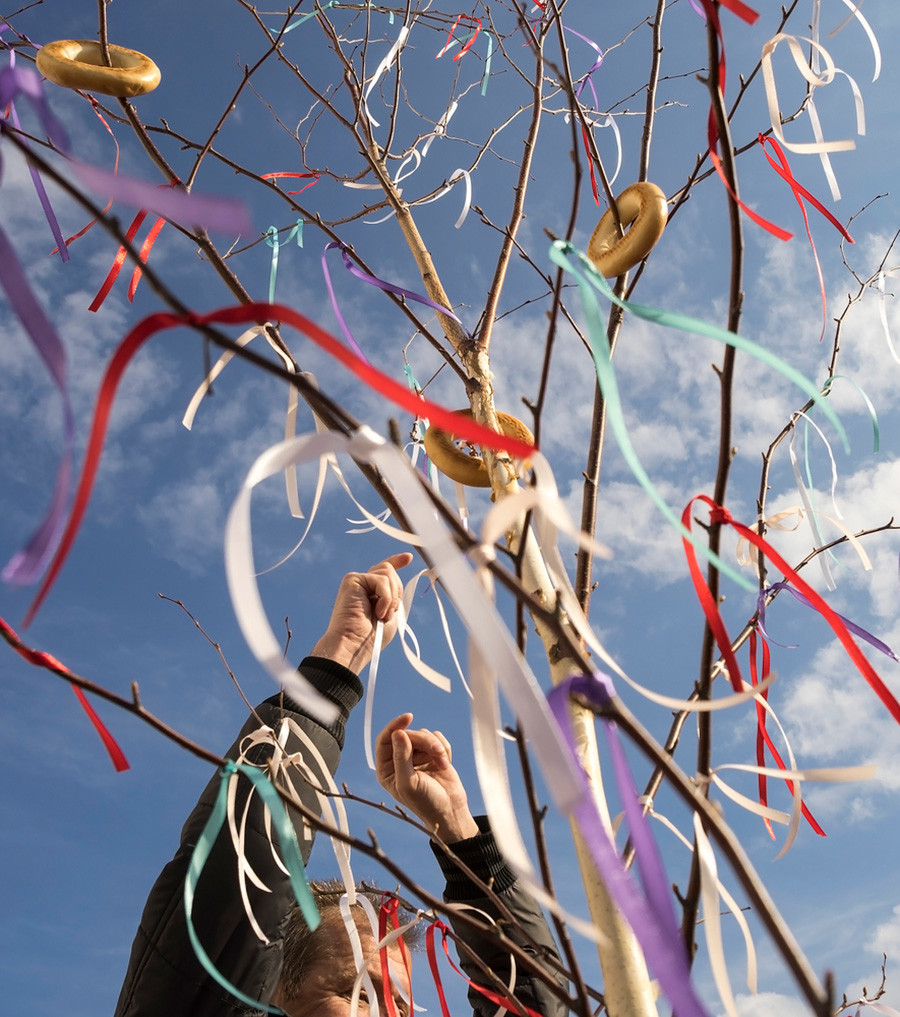
Tying a ribbon is a national tradition
There is a beautiful legend about Yugra’s origins. In one very bright, warm and sunny city, twins of unprecedented beauty were born: a brother named Yug and a sister named Ra. At first, they grew up like ordinary small children, but with age they began to argue and fight, so much so that when they did flames flared up around them. The townspeople were afraid that they would burn everything down, so they exiled Yug and Ra to a remote northern land covered with ice and snow. The brother and sister illuminated this land with their light and made it warm so that people could come here to live. Yug and Ra stopped fighting and began living together in harmony. Since then, this northern land has been called Yugra.
When you look at the map, it may seem that Khanty-Mansiysk is located almost in the middle of Russia. However, the climate here is similar to regions of the Far North. In winter, the temperature here drops to below -40 degrees Celsius.
We asked local residents and people who know this region well to tell us more about it and to share some tips for tourists who come to visit.
Why should a foreigner visit Khanty-Mansiysk?
“If you want to feel the coldness and colors of Russian winter, then you should definitely stop by in our small cozy town,” says a local tattoo artist, Semyon Chepurnoy.
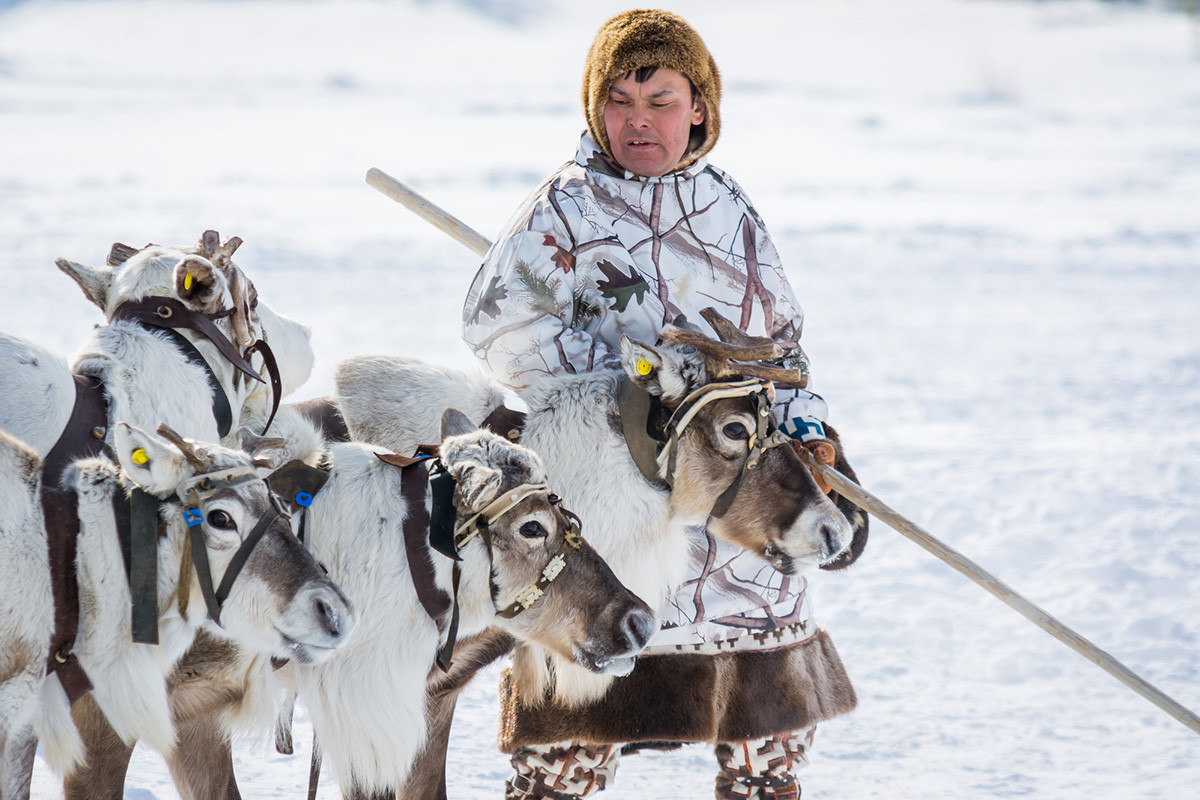
A Khanty man in a traditional dress
Yevgeny Zinovyev, a journalist and the former editor-in-chief of a local media outlet, says that Khanty-Mansiysk provides the opportunity to experience a real and not touristy part of Russia. “In winter, there are frosts, snowdrifts and wind. In summer, heat, midges and bears. At any time of the year, you can experience the everyday life and customs of the indigenous peoples: the Khanty and Mansi. And of course, in Khanty-Mansiysk you can get to know the backbone of modern Russia – its oil and gas sector."
“We have unique scenery here. Khanty-Mansiysk is located on seven hills and is surrounded by the taiga. There are a lot of fish in the rivers, and a lot of mushrooms, berries and pine nuts in the forests surrounding the city,” says local insurance company employee Sergey Yankovich.

View of the city and the Irtysh River
The harsh climate of the region influences how local residents relate to visitors. “Residents of the city are very good-natured and welcoming and are always ready to offer help in any situation, even to a stranger, because in the north, there is an unspoken rule: If you see that a person is in distress, be sure to help them, because tomorrow, it may be you in their place. The harsh climate and surrounding scenery leave no room for error, especially in winter,” Sergey says.
Things to see/do/taste in Khanty-Mansiysk
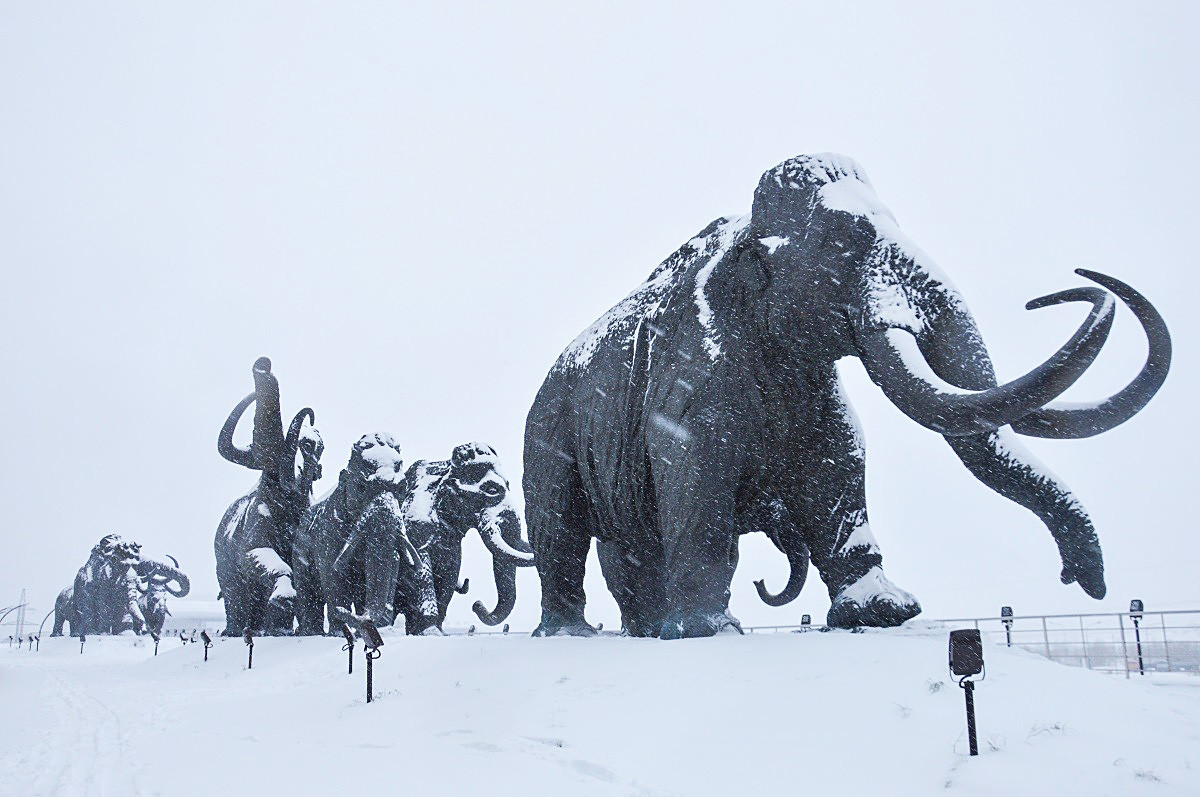
Mammoths at the Archeopark
According to Irina Pudova, a local resident and the author of a collection of legends called Yugra: It’s My land , the first thing to do in Khanty-Mansiysk is to see the local mammoths. Seven life-size bronze prehistoric animals "roam" the area near Samarovsky Hill on the grounds of the Archeopark complex. Here you will also find a prehistoric bison, a pack of wolves, a cave bear, two woolly rhinos and prehistoric people themselves.
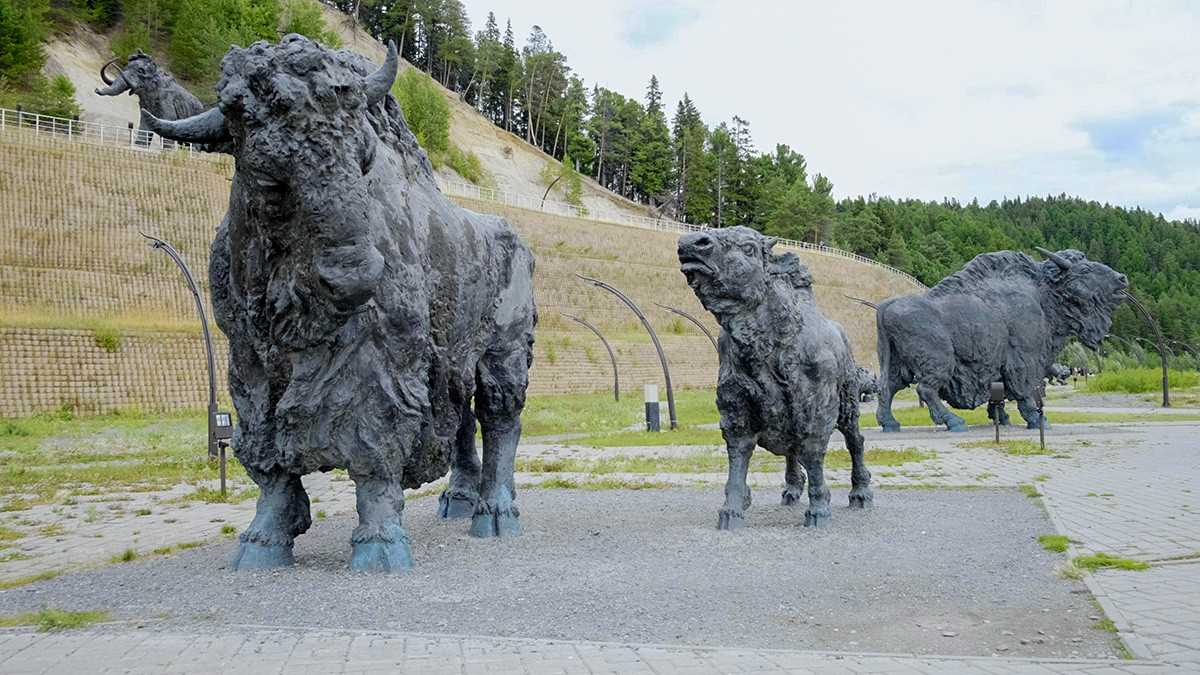
Sculptures of bisons at the Archeopark cultural and tourist complex
“Then you could get something to eat,” Irina advises. “The thing to do is to go to any local restaurant of Siberian cuisine and ask for muksun. It is a valuable freshwater fish of the salmon family, which is highly prized by locals and tourists alike.”
Khanty-Mansiysk is a relatively new city and only received this status in 1950. Soo oil was discovered in the region, prompting a dramatic push in its development. Prior to that, there were just Siberian settlements built by Russia in the late 16th century. Irina is impressed that a modern city was built in such harsh conditions.
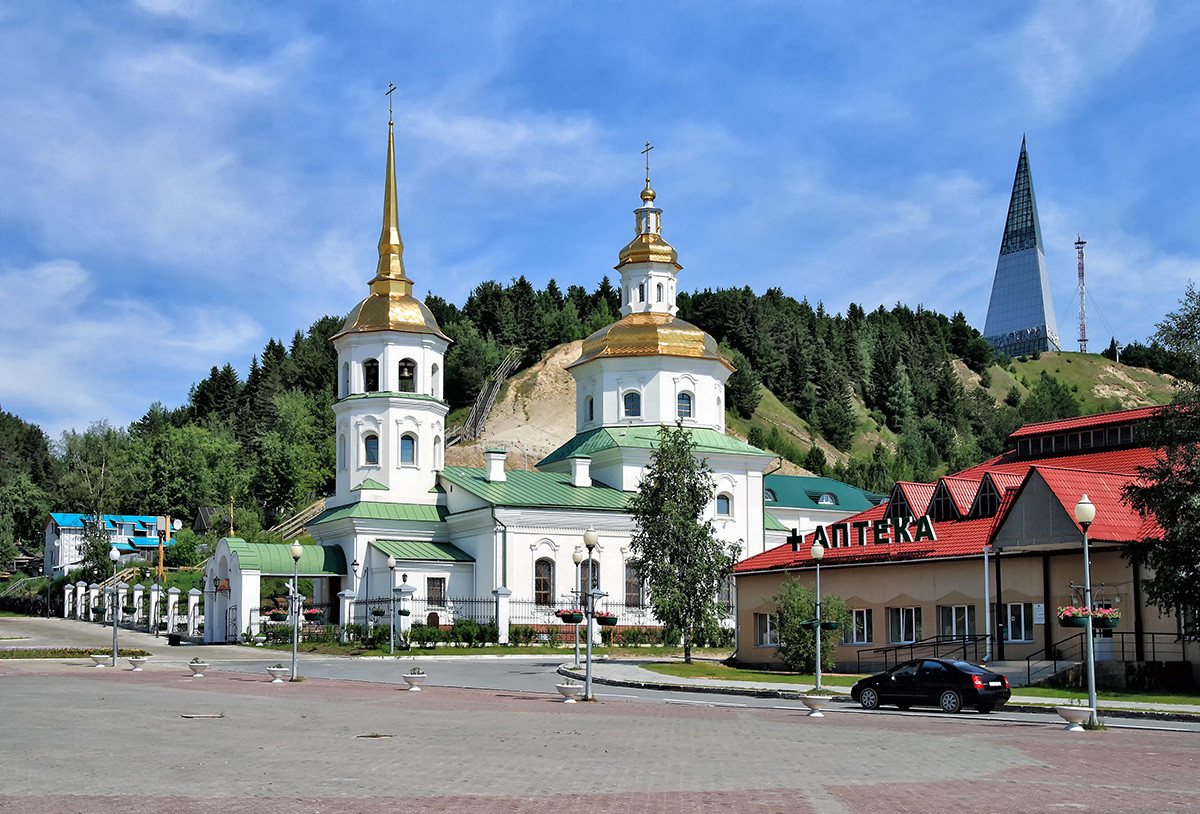
The Church of the Protection of the Holy Virgin
“Cultural objects, squares, houses - all this is unique. And everything is new, there is nothing very ancient here. Except for mammoths!” she says.
In addition to the Archeopark mentioned above, Yevgeny Zinovyev’s list of favorite places in the city includes the Museum of Geology, Oil and Gas, along with the Museum of Nature and Man and the centuries-old cedars in the Samarovsky Chugas natural park. He recommends checking out the views from the observation deck near the Monument to the Explorers of the Yugra Land and paying a visit to a local bathhouse.
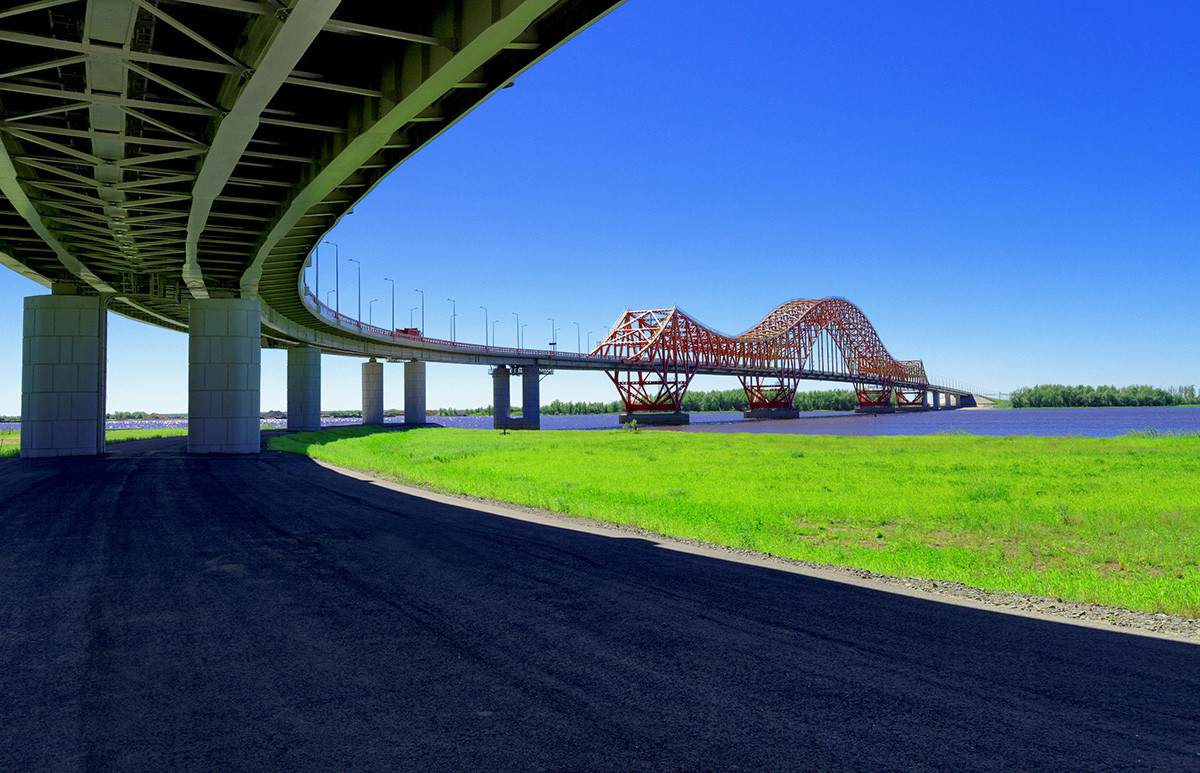
'Red Dragon' bridge over the Irtysh River
Yevgeny also provided us a checklist of culinary delights that anyone visiting Khanty-Mansiysk should be sure to try:
- Muksun (in any form but best of all frozen and sliced as Stroganina).
- Wild berries (cranberry, cowberry, cloudberry).
- Venison (in any form but best of all stewed and sprinkled with frozen berries and pine nuts).
Sergey Yankovich recommends visiting the open-air ethnographic museum Torum Maa, which means "Sacred Land" in Mansi. “There you can get acquainted with the history of the city and the district, as well as with the life of the indigenous peoples of the Khanty and Mansi, who belong to the Finno-Ugric group,” Sergey says.

Torum Maa ethnic center
In addition, he advises anyone who comes to Khanty-Mansiysk to visit the spot where the Ob and Irtysh rivers meet, pay a visit to Misne Hotel’s restaurant and taste traditional dishes there, as well as dishes prepared by local fishermen and hunters while in the taiga.
According to Semyon Chepurnoy, the Valley of Streams natural park is another must for any visitor. It is one of local residents’ favorite recreation areas, where you can stroll along a dedicated footpath offering stunning views of the city. Semyon also advises trying pancakes at the GoodFood chain of cafes.
What are the best souvenirs?
“We all love something mystical and supernatural. There is a strong culture of shamanism here, so I think it’s cool to take with you some local amulets charged by a shaman—a bear claw or a pendant made of beads and deerskin,” says Irina Pudova.
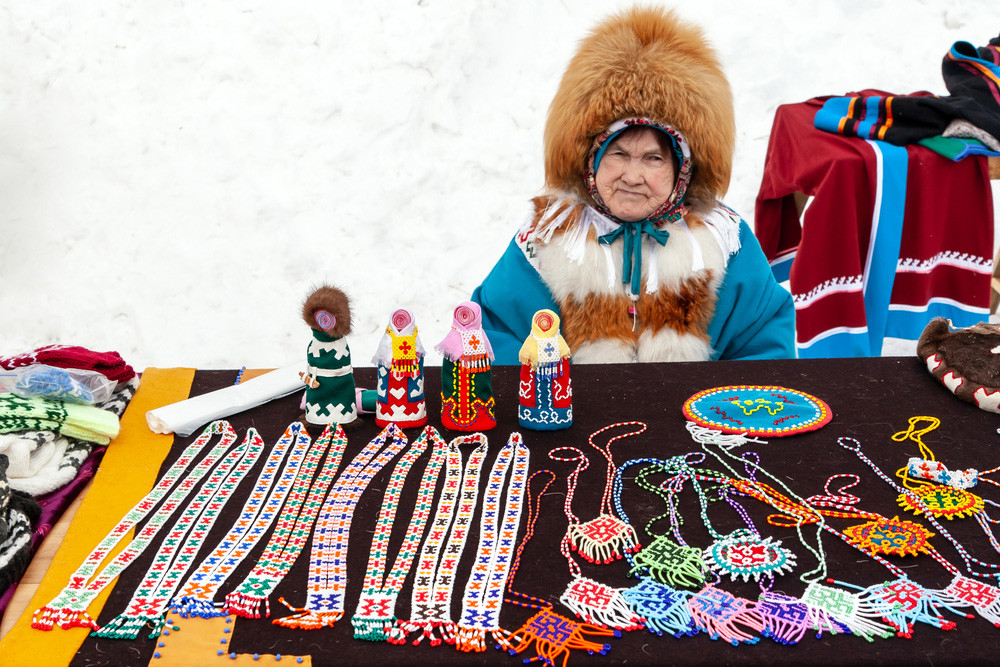
A Khanty woman in the traditional dress selling souvenirs
Sergey Yankovich advises that authentic souvenirs can be found at the Crafts Center on Roznina Street. “There you can also see and even try on the national costumes of the Khanty and Mansi and try to solve traditional puzzles that representatives of the indigenous peoples made for their children.”
According to Yevgeny Zinovyev, the best souvenirs are Khanty and Mansi amulets, clothes, jewelry, as well as traditional local treats such as muksun, wild berries, pine nuts and venison.
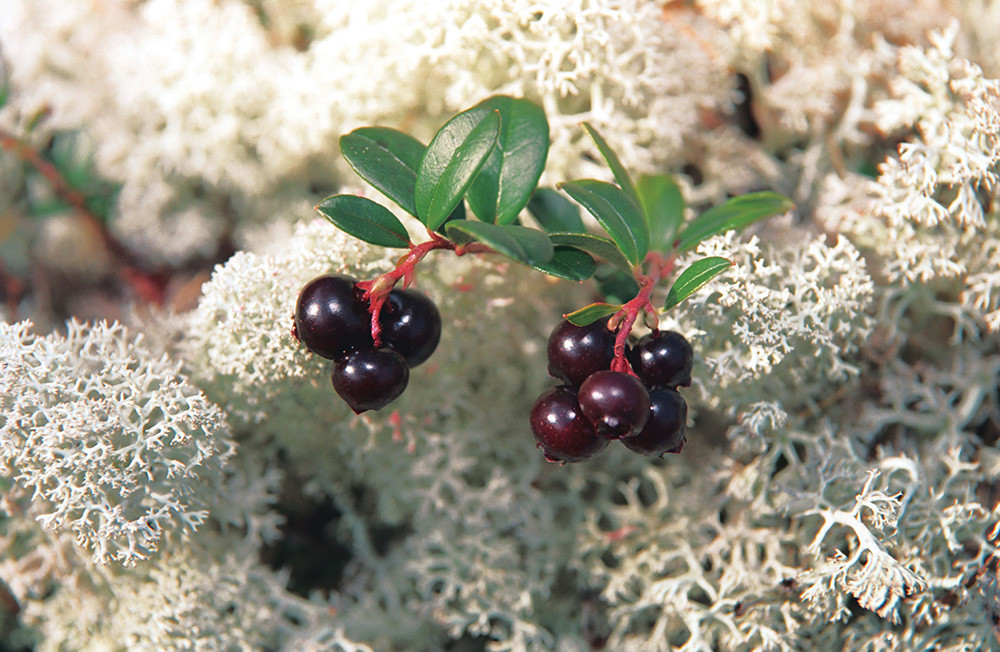
Cowberry bush
For his part, Semyon Chepurnoy recommends bringing away memories and photographs as well as a little bit of Siberian Frost ❄.
If using any of Russia Beyond's content, partly or in full, always provide an active hyperlink to the original material.
to our newsletter!
Get the week's best stories straight to your inbox
- 10 main stops on the Trans-Siberian Railway
- Naryan-Mar: Why you should visit this remote Arctic city
- An expat’s confession: Why I miss the city by the Amur – Khabarovsk
This website uses cookies. Click here to find out more.
- Even-toed Ungulates
- Edit source
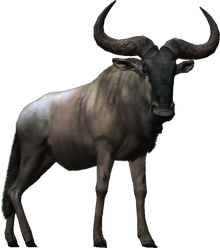
Model of Bull for BBHD
The Wildebeest is the 9th main animal to be introduced to the Big Buck universe , and the 3rd main animal in Big Buck Safari . It made its debut on Big Buck Safari in 2008, and was remade for Big Buck HD in 2012.
- 2 Trophy Animals (Safari)
- 3 Critters (Safari)
- 4 Bonus Games (Safari)
- 5 Dangerous Trophies (HD)
- 6 Bonus Games (HD)
- Oao Bolo, Ethiopia
- Nakuru, Kenya
- Mambali, Tanzania
- Makoko, Zambia
- Kobojango, Botswana
- Lumbala, Angola
Trophy Animals (Safari) [ ]
- Black Panther
- African Elephant
- White Rhino
- Hippopotamus
Critters (Safari) [ ]
- Yellow-billed Stork
- Ring-tailed Lemur
Bonus Games (Safari) [ ]
- Waterfall Bonus
- Frog Hop Bonus
- Pinwheel Bonus
Dangerous Trophies (HD) [ ]
Bonus games (hd) [ ].
- Wormhole Bonus
- Flytrap Bonus
- The Safari version had the voiceover done by an African-accented person, while in the HD version, he was replaced by George Petro's Southern accent.
Khanty-Mansi Autonomous Okrug
Khanty-Mansi Autonomous Okrug — Yugra [lower-alpha 1] , commonly shortened to Khantia-Mansia, is a federal subject of Russia (an autonomous okrug of Tyumen Oblast ). It has a population of 1,532,243 as of the 2010 Census . [4] Its administrative center is located at Khanty-Mansiysk .
Administrative divisions
Demographics, settlements, ethnic groups, vital statistics, external links.
The peoples native to the region are the Khanty and the Mansi , known collectively as Ob-Ugric peoples , but today the two groups only constitute 2.5% of the region's population. The local languages, Khanty and Mansi , are part of the Ugric branch of the Finno-Ugric language family, and enjoy a special status in the autonomous okrug. Russian remains the only official language.
In 2012, the majority (51%) [7] of the oil produced in Russia came from Khanty-Mansi Autonomous Okrug, giving the region great economic importance in Russia and the world. It borders Yamalo-Nenets Autonomous Okrug to the north, Komi Republic to the northwest, Sverdlovsk Oblast to the west, Tyumen Oblast to the south, Tomsk Oblast to the south and southeast and Krasnoyarsk Krai in the east.
The okrug was established on December 10, 1930, as Ostyak-Vogul National Okrug ( Остя́ко-Вогу́льский национа́льный о́круг ). In October 1940, it was renamed the Khanty-Mansi National Okrug . In 1977, along with other national okrugs of the Russian SFSR , it became an autonomous okrug (Khanty-Mansi Autonomous Okrug). In 2003, the word " Yugra " was appended to the official name. [8]

The okrug occupies the central part of the West Siberian Plain .
Principal rivers include the Ob and its tributaries Irtysh and Vatinsky Yogan . There are numerous lakes in the okrug, the largest ones are Numto , Tormemtor , Leushinsky Tuman and Tursuntsky Tuman , among others. [9]
The northeasterly line of equal latitude and longitude traverses the Khanty-Mansi Autonomous Okrug.
Population : 1,674,676 (2020); [10] 1,532,243 ( 2010 Russian census ) ; [4] 1,432,817 ( 2002 Census ) ; [11] 1,268,439 ( 1989 Soviet census ) . [12]
Khanty-Mansi Autonomous Okrug has an area of 523,100 km 2 , but the area is sparsely populated. The administrative center is Khanty-Mansiysk , but the largest cities are Surgut , Nizhnevartovsk , and Nefteyugansk .
The Indigenous population ( Khanty , Mansi , Komi , and Nenets ) is only 2.8% of the total population in the Khanty-Mansi Autonomous Okrug. The exploitation of natural gas in Khanty-Mansi Autonomous Okrug has attracted immigrants from all over the former Soviet Union. The 2021 Census counted 17 ethnic groups of more than five thousand persons each. The ethnic composition is as follows:
Population of Khanty-Mansi Autonomous Okrug: [13]
Historical population figures are shown below:

Source: [15]

According to a 2012 survey [16] 38.1% of the population of Yugra adheres to the Russian Orthodox Church , 5% are unaffiliated generic Christians , 1% of the population adheres to the Slavic native faith (Rodnovery) or to Khanty-Mansi native faith. Muslims (mostly Tatars ) constitute 11% of the population. In addition, 23% of the population declares to be spiritual but not religious , 11% is atheist , and 10.9% follows other religions or did not give an answer to the question. [16] According to recent reports Jehovah's Witnesses have been subjected to torture and detention in Surgut. [18]
In Khanty-Mansi Autonomous Okrug, the primary transport of goods is by water and railway transport; 29% is transported by road, and 2% by aviation. The total length of railway tracks is 1,106 km. The length of roads is more than 18,000 km.
- Hockey Club Ugra
- List of Chairmen of the Duma of the Khanty-Mansi Autonomous Okrug
Related Research Articles

Khanty-Mansiysk is a city in west-central Russia. Technically, it is situated on the eastern bank of the Irtysh River, 15 kilometers (9.3 mi) from its confluence with the Ob, in the oil-rich region of Western Siberia. Though it is an independent city, Khanty-Mansiysk also functions as the administrative centre of Khanty-Mansiysky District, and the administrative center of Khanty-Mansi Autonomous Okrug–Yugra.
Nyagan is a town in the northwest of Khanty–Mansi Autonomous Okrug, Russia, located near the Ob River and 230 kilometers (140 mi) northwest of Khanty-Mansiysk. It is named after the Nyagan-Yugan River, a tributary of the Ob River. Population: 63,034 (2021 Census) ; 54,890 (2010 Russian census) ; 52,610 (2002 Census) ; 54,061 (1989 Soviet census) .

Megion is a town in Khanty-Mansi Autonomous Okrug–Yugra, Russia, located at the altitude of 45 meters (148 ft) above sea level, on the right bank of the Ob River, 380 kilometers (240 mi) east of Khanty-Mansiysk and 760 kilometers (470 mi) northeast of Tyumen. The area of the town is 50.51 square kilometers (19.50 sq mi) and the nearest airport is in Nizhnevartovsk. Population: 49,449 (2010 Russian census) ; 46,566 ; 39,783 (1989 Soviet census) .

Yugorsk is a town in Khanty–Mansi Autonomous Okrug, Russia, located in the northwestern part of the East-West lowland, 420 kilometers (260 mi) from Khanty-Mansiysk. Population: 34,067 (2010 Russian census) ; 30,285 (2002 Census) ; 24,928 (1989 Soviet census) .

Sovetsky is a town and the administrative center of Sovetsky District in Khanty-Mansi Autonomous Okrug, Russia, located 470 kilometers (290 mi) west of Khanty-Mansiysk, the administrative center of the autonomous okrug. Population: 26,495 (2010 Russian census) ; 23,230 (2002 Census) ; 21,123 (1989 Soviet census) .
Lyantor is a town in Surgutsky District of Khanty–Mansi Autonomous Okrug, Russia, located on the Pim River, 625 kilometers (388 mi) northeast of Khanty-Mansiysk, the administrative center of the autonomous okrug. Population: 38,992 (2010 Russian census) ; 33,011 (2002 Census) ; 22,071 (1989 Soviet census) .

Pokachi is a town in Khanty–Mansi Autonomous Okrug, Russia, located on the right bank of the Vatyegan River, 350 kilometers (220 mi) east of Khanty-Mansiysk and 800 kilometers (500 mi) northeast of Tyumen. Population: 17,171 (2010 Russian census) ; 17,017 (2002 Census) ; 11,536 (1989 Soviet census) .
Kogalym is a town in Khanty-Mansi Autonomous Okrug, Russia, located on the Inguyagun River 325 kilometres (202 mi) northeast of Khanty-Mansiysk. Population: 58,181 (2010 Russian census) ; 55,367 (2002 Census) ; 44,297 (1989 Soviet census) .

Beloyarsky is a town and the administrative center of Beloyarsky District in Khanty-Mansi Autonomous Okrug, Russia, located on the Kazim River, northwest of Khanty-Mansiysk, the administrative center of the autonomous okrug. Population: 20,283 (2010 Russian census) ; 18,721 (2002 Census) ; 20,534 (1989 Soviet census) .

Raduzhny is a town in Khanty-Mansi Autonomous Okrug, Russia, located on the Agan River, 475 kilometers (295 mi) northeast of Khanty-Mansiysk and 975 kilometers (606 mi) northeast of Tyumen. Population: 43,399 (2010 Russian census) ; 47,060 ; 43,726.

Pyt-Yakh is a town in Khanty–Mansi Autonomous Okrug, Russia, located on the east bank of the Bolshoy Balyk River, southeast of Khanty-Mansiysk. Population: 41,488 (2010 Russian census) ; 41,813 (2002 Census) ; 17,101 (1989 Soviet census) .

Beloyarsky District is an administrative and municipal district (raion), one of the nine in Khanty-Mansi Autonomous Okrug of Tyumen Oblast, Russia. It is located in the north of the autonomous okrug. The area of the district is 41,574 square kilometers (16,052 sq mi). Its administrative center is the town of Beloyarsky. Population: 9,766 ; 9,493 (2002 Census) ; 8,927 (1989 Soviet census) .

Khanty-Mansiysky District is an administrative and municipal district (raion), one of the nine in Khanty-Mansi Autonomous Okrug, Russia. It is located in the center of the autonomous okrug. The area of the district is 46,400 square kilometers (17,900 sq mi). Its administrative center is the town of Khanty-Mansiysk. As of the 2010 Census, the total population of the district was 19,362.

Kondinsky District is an administrative and municipal district (raion), one of the nine in Khanty-Mansi Autonomous Okrug of Tyumen Oblast, Russia. It is located in the south of the autonomous okrug. The district is 55,170 square kilometers (21,300 sq mi). Its administrative center is the urban locality of Mezhdurechensky. Population: 34,494 ; 35,018 (2002 Census) ; 36,640 (1989 Soviet census) . The population of Mezhdurechensky accounts for 32.1% of the district's total population.

Nizhnevartovsky District is an administrative and municipal district (raion), one of the nine in Khanty-Mansi Autonomous Okrug, Russia. The area of the district is 118,500 square kilometers (45,800 sq mi). Its administrative center is the city of Nizhnevartovsk. Population: 35,745 ; 33,508 (2002 Census) ; 28,288 (1989 Soviet census) .

Oktyabrsky District is an administrative and municipal district (raion), one of the nine in Khanty-Mansi Autonomous Okrug of Tyumen Oblast, Russia. It is located in the western central part of the autonomous okrug. The area of the district is 24,500 square kilometers (9,500 sq mi). Its administrative center is the urban locality of Oktyabrskoye. As of the 2010 Census, the total population of the district was 32,224, with the population of Oktyabrskoye accounting for 11.3% of that number.

Sovetsky District is an administrative and municipal district (raion), one of the nine in Khanty-Mansi Autonomous Okrug of Tyumen Oblast, Russia. It is located in the southwest of the autonomous okrug. The area of the district is 29,768.74 square kilometers (11,493.77 sq mi). Its administrative center is the town of Sovetsky. Population: 48,059 ; 44,720 (2002 Census) ; 73,247 (1989 Soviet census) . The population of the administrative center accounts for 55.1% of the district's total population.

Surgutsky District is an administrative and municipal district (raion), one of the nine in Khanty-Mansi Autonomous Okrug, Russia. It is located in the center of the autonomous okrug. The area of the district is 105,190 square kilometers (40,610 sq mi). Its administrative center is the city of Surgut. Population: 113,515 ; 106,624 (2002 Census) ; 74,685 (1989 Soviet census) .

Uray a town in Khanty–Mansi Autonomous Okrug, located on the Konda River 350 kilometres (220 mi) from Khanty-Mansiysk. Population: 39,457 (2010 Russian census) ; 38,872 (2002 Census) ; 37,198 (1989 Soviet census) .

Agirish is an urban-type settlement in Sovetsky District of Khanty-Mansi Autonomous Okrug, Russia. Population: 2,856 (2010 Russian census) ; 2,831 (2002 Census) ; 3,592 (1989 Soviet census) .
- ↑ Russian and Mansi : Ханты-Мансийский автономный округ — Югра, Khanty-Mansiyskiy avtonomnyy okrug — Yugra; Khanty : Хӑнты-Мансийской Aвтономной Округ
- ↑ Президент Российской Федерации. Указ №849 от 13 мая 2000 г. «О полномочном представителе Президента Российской Федерации в федеральном округе». Вступил в силу 13 мая 2000 г. Опубликован: "Собрание законодательства РФ", No. 20, ст. 2112, 15 мая 2000 г. (President of the Russian Federation. Decree # 849 of May 13, 2000 On the Plenipotentiary Representative of the President of the Russian Federation in a Federal District . Effective as of May 13, 2000.).
- ↑ Госстандарт Российской Федерации. №ОК 024-95 27 декабря 1995 г. «Общероссийский классификатор экономических регионов. 2. Экономические районы», в ред. Изменения №5/2001 ОКЭР. ( Gosstandart of the Russian Federation. # OK 024-95 December 27, 1995 Russian Classification of Economic Regions. 2. Economic Regions , as amended by the Amendment # 5/2001 OKER. ).
- 1 2 3 Russian Federal State Statistics Service (2011). Всероссийская перепись населения 2010 года. Том 1 [ 2010 All-Russian Population Census, vol. 1 ] . Всероссийская перепись населения 2010 года [2010 All-Russia Population Census] (in Russian). Federal State Statistics Service .
- ↑ "Об исчислении времени" . Официальный интернет-портал правовой информации (in Russian). June 3, 2011 . Retrieved January 19, 2019 .
- ↑ Official throughout the Russian Federation according to Article 68.1 of the Constitution of Russia .
- ↑ В Ханты-Мансийском автономном округе добыта 10-миллиардная тонна нефти
- ↑ "Decree of the President of the Russian Federation of July 25, 2003 No. 841" (in Russian). Official website of the President of Russia .
- ↑ Google Earth
- ↑ 2020 Russian Subjects Population
- ↑ Federal State Statistics Service (May 21, 2004). Численность населения России, субъектов Российской Федерации в составе федеральных округов, районов, городских поселений, сельских населённых пунктов – районных центров и сельских населённых пунктов с населением 3 тысячи и более человек [ Population of Russia, Its Federal Districts, Federal Subjects, Districts, Urban Localities, Rural Localities—Administrative Centers, and Rural Localities with Population of Over 3,000 ] (XLS) . Всероссийская перепись населения 2002 года [All-Russia Population Census of 2002] (in Russian).
- ↑ Всесоюзная перепись населения 1989 г. Численность наличного населения союзных и автономных республик, автономных областей и округов, краёв, областей, районов, городских поселений и сёл-райцентров [ All Union Population Census of 1989: Present Population of Union and Autonomous Republics, Autonomous Oblasts and Okrugs, Krais, Oblasts, Districts, Urban Settlements, and Villages Serving as District Administrative Centers ] . Всесоюзная перепись населения 1989 года [All-Union Population Census of 1989] (in Russian). Институт демографии Национального исследовательского университета: Высшая школа экономики [Institute of Demography at the National Research University: Higher School of Economics]. 1989 – via Demoscope Weekly .
- ↑ "Russian Census of 2021" . (in Russian)
- ↑ Перепись-2010: русских становится больше Archived December 25, 2018, at the Wayback Machine . Perepis-2010.ru (2011-12-19). Retrieved on 2013-08-20.
- ↑ Russian Federal State Statistics Service
- 1 2 3 "Arena: Atlas of Religions and Nationalities in Russia" . Sreda, 2012.
- ↑ 2012 Arena Atlas Religion Maps . "Ogonek", № 34 (5243), 27/08/2012. Retrieved 21/04/2017. Archived .
- ↑ "7 Jehovah's Witnesses Brutally Tortured in Russia, Spokesman Says" . February 20, 2019.
- Official website of Khanty-Mansiysk Autonomous Okrug – Yugra Archived June 6, 2017, at the Wayback Machine
- Official site of Khanty-Mansi Duma (in Russian)
- Informational website of Khanty-Mansiysk Autonomous Okrug – Yugra (in Russian)
Surgut map, satellite – loading . . .
Khanty-mansiyskiy avtonomnyy okrug - yugra, 🌍 surgut map.
Name: Surgut
Latitude: 61°15'00"N
Longitude: 73°25'00"E
City: Surgut
Region: Surgut
Region: Khanty-Mansiysk Autonomous Okrug – Ugra
Region: Ural Federal District
Country: Russia

IMAGES
VIDEO
COMMENTS
Big Buck Safari was the 6th park ranger game to be released to arcades in the Big Buck Hunter franchise. This was the 1st game to introduce hunting in Africa, and also the 1st to introduce trophy hunting. It was released in 2009. A console version for Wii and an app version for iOS were both released in 2011. Sable Kudu Wildebeest Gemsbok Cape Buffalo Zebra African Elephant Giraffe Lion White ...
The Elephant is a Big Game Trophy found in Gemsbok only. Prior to this, it was a Trophy Animal on Big Buck Safari & World. On the latter game, this animal would only appear in the African Adventures. The Elephant is featured in the Jumbo Dropkick Bonus in Big Buck Safari Outback, where they kick the soccer balls as targets, even though the Asian Elephant is the elephant native to India. On ...
The Narrator the African Elephant is the largest mammal on earth, and a member of the family Elephantidae. ... Big Buck Safari Wiki 32. pages. Explore. Main Page; Discuss; All Pages; Community; Interactive Maps; Recent Blog Posts; Wiki Content. Recently Changed Pages. Buttercup; Big f*** Safari;
Big Buck Safari® takes you across the entire continent of Africa as you hunt Gemsbok, Kudu, Sable, Cape Buffalo, Wildebeest and countless critters. The Trophy Animal adds a new twist to the game play by challenging the player to go after the elusive animals like Elephants, Giraffes, Rhinos and more. Available as a 27" standard upright ...
Big Game Trophies: Elephant, Rhino, Giraffe, Okapi (Secret) Critters: Klipspringer, Hornbill, Jackal, Chameleon, Crocodile, plus any other critter from Kudu, Wildebeest, and Gemsbok. BONUS GAMES. Turtle Touchdown Bonus - "Shoot the Turtles" Turtle Touchdown Bonus is a sequel/reimagining of the Turtle Toss Bonus from Big Buck Safari.
Render of the largest land mammal in the world, the African Bush Elephant from Big Buck Safari. It's one of many and the biggest of trophy animals found in Sable, Kudu, Wildebeest, Gemsbok, Ibex, and Cape Buffalo Adventures.
Big Buck Safari offers eight 'Trophy Animals: Lions, Rhinos, Elephants, Panthers, Leopards, Giraffes, Zebras and Hippos to significantly raise scores. In this new version, players will also find several new critters to hunt including Meerkats, Chameleons, Frogs, Hyenas, Warthogs and spiders just to name a few. New main quarry animals to hunt ...
Big Buck Safari® takes you across the entire continent of Africa hunting Wildebeest, countless critters, and the 8 new trophy animals, which add a new twist to the game by challenging the player ...
Big Buck Safari is an all new, action packed hunting game that brings new and exciting challenges to players and increased earning potential to operators. Safari puts players on a Big-Game Hunting Safari across the dark continent of Africa. Players will experience 15 unique hunting treks stretching from desert dunes through grassy savannas to ...
Game added by HelloMrKearns. Sure Shot HD added by firefang9212. Game added June 6, 2017. Last modified May 24, 2024. An arcade light gun hunting game. Big Buck Safari takes place in Africa and lets the player hunt Gemsbok, Kudu, Sable, Cape Buffalo, Wildebeest, Elephants, Giraffes, Rhinos and more.
Big Buck World is the 8th game in the Big Buck Hunter series and is the final Generation 2 game of the series. Big Buck World contains 2 heavily expanded versions of Big Buck Hunter Pro and Big Buck Safari, those games being Big Buck Hunter Pro: Open Season and Big Buck Safari: Outback. While Big Buck Hunter Pro: Open Season was released as an individual cabinet the year prior to Big Buck ...
Big Buck Safari Asian Elephant #1. By. DipperBronyPines98. Watch. Published: Feb 25, 2022. 5 Favourites. 0 Comments. 1K Views. asia big buck india indian safari arcade arcadegame arcadegames asianelephant elephant elephants biggamehunter. Description. Render of the Asian Elephant from Big Buck Safari. It's one of the many trophy animals found ...
Big Buck Safari African Elephant #5. By. DipperBronyPines98. Watch. Published: Feb 25, 2022. 5 Favourites. 0 Comments. 1.1K Views. big buck africa african africananimals africanelephant africanwildlife arcade arcadegame arcadegames elephant elephants safari biggamehunter. Image size. 1280x853px 317.94 KB
This is a Big Buck Hunter safari arcade game made by Raw Thrills and released in 2007. Big Buck Safari offers eight 'Trophy Animals: Lions, Rhinos, Elephants, Panthers, Leopards, Giraffes, Zebras and Hippos. In this version, players will also find several new critters to hunt including Meekest, Chameleons, Frogs, Hyenas, Warthogs and spiders ...
Buck hunts a trophy Bull Elephant in Zimbabwe Africa. The hunters slip to within 30 yards of 3 old Bulls then take the big tusker. From the TV show "THE OUTD...
The Khanty-Mansiysk Autonomous Area (KhMAO) was established in 1930. Its name comes from two main northern indigenous peoples - the Khanty and the Mansi. From 1944 it was legally part of the Tyumen Region, but in 1993 the Area received autonomy and became a full-fledged territorial entity of the Russian Federation.
Mesoron (Schizotheriinae) is a subfamily of the family Chalicotheriidae, a group of herbivorous, odd-toed ungulate (perissodactyl) mammals. Unlike the gorilla-like proportions of the chalico, the only living member of the Chalicotheriinae subfamily, mesorons have smaller body proportions, closer to those of the most famous species of native American mesoron, the Common American Mesoron ...
According to Irina Pudova, a local resident and the author of a collection of legends called Yugra: It's My land, the first thing to do in Khanty-Mansiysk is to see the local mammoths. Seven ...
The Wildebeest is the 9th main animal to be introduced to the Big Buck universe, and the 3rd main animal in Big Buck Safari. It made its debut on Big Buck Safari in 2008, and was remade for Big Buck HD in 2012. Safari Oao Bolo, Ethiopia Nakuru, Kenya Mambali, Tanzania HD Makoko, Zambia Kobojango, Botswana Lumbala, Angola Lion Leopard Black Panther African Elephant White Rhino Hippopotamus ...
Khanty-Mansi Autonomous Okrug — Yugra, commonly shortened to Khantia-Mansia, is a federal subject of Russia (an autonomous okrug of Tyumen Oblast). It has a population of 1,532,243 as of the 2010 Census. Its administrative center is located at Khanty-Mansiysk. Khanty-Mansi Autonomous Okrug - WikiMil
All streets and buildings location of Surgut on the live satellite photo map. Europe online Surgut map. 🌍 map of Surgut (Russia / Khanty-Mansiyskiy Avtonomnyy Okrug - Yugra), satellite view. Real streets and buildings location with labels, ruler, places sharing, search, locating, routing and weather forecast.